Captain America: The Winter Soldier & Civil War
When Captain America throws his mighty shield! All those who choose to oppose his shield must yield!
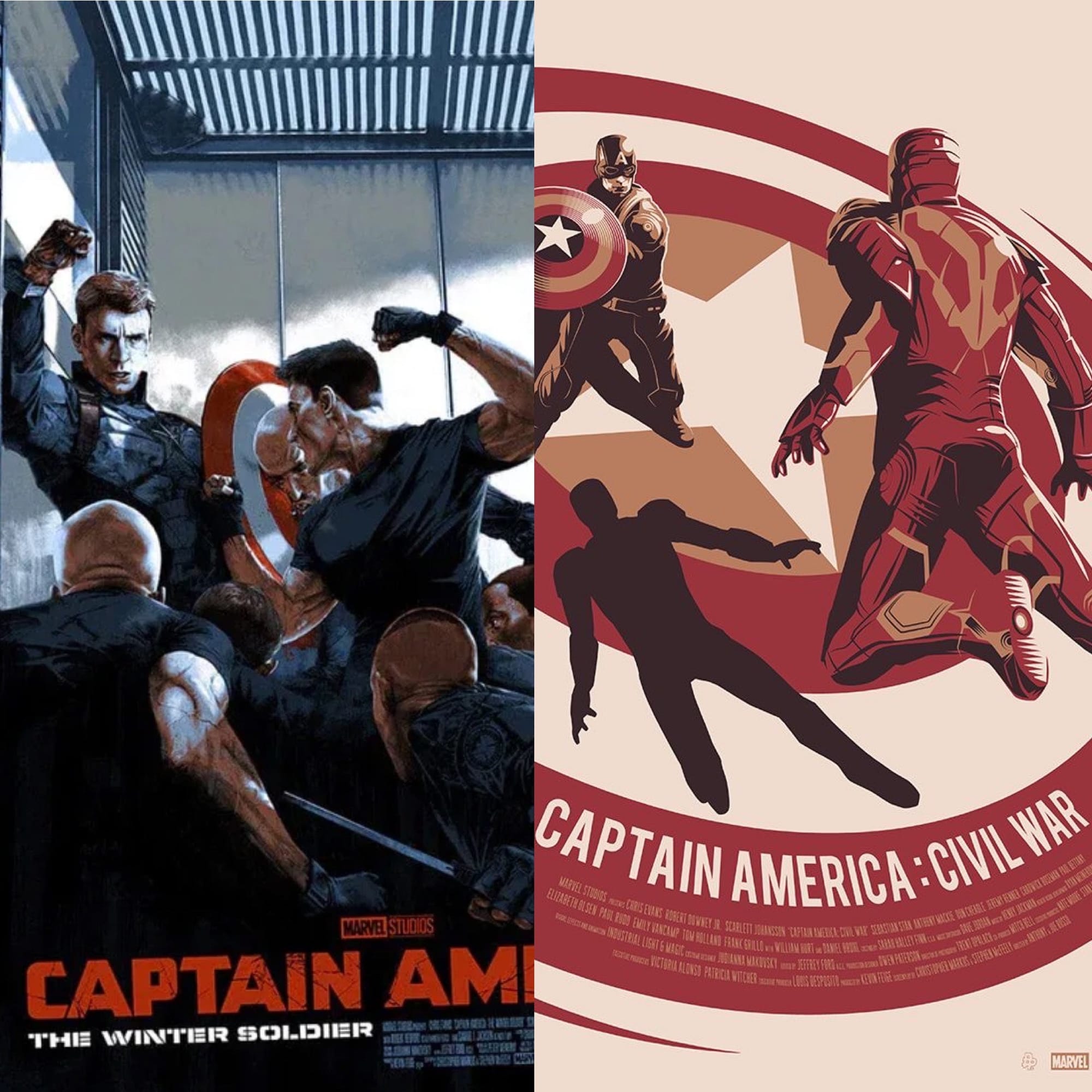
I decided to rewatch some of my favorite films.
These are all films that I haven’t talked about here yet, films like Children of Men, Aliens, Pee Wee Herman’s Big Adventure, Chinatown, Goodfellas, Casablanca, Blue Ruin, Green Room, Terminator, Rogue One, Nightcrawler, and the Assassination of Jesse James by the Coward Robert Ford, to name a few. As you’re probably all aware at this point, I don’t go to theatres anymore because COVID is still happening, and the risk of paying way too much money for a subpar film, AND getting sick from COVID on top of that, as well as possibly ending up with a long-term disability due to Long COVID, is just too great, but what with a lot of big franchise sequels on the way, I was thinking of getting ready for them eventually showing up on streaming platforms by revisiting films like Dune, the Mad Max movies, and the new Planet of the Apes too. I might even re-watch the latest Bat-film too. The Batman generally felt too long to me, was kind of underwhelming, and mostly left me feeling cold and unimpressed the first time I watched it, but maybe it’s a film that deserves a second look.
Maybe.
This is a casual idea, of course, there’s no pressure to get any of it done in any kind of time frame, or to even do it at all, if I’m being honest, but I figure, I like these films, so why not? After all, rewatching movies is often a better experience than watching them for the first time.
In the book The Films In My Life by the French filmmaker Francois Truffaut, he recounts a story from when he was a boy in 1942, and he was so excited to see Marcel Carnk's film Les Visiteurs du Soir that he skipped school to see it. He loved it, but that night, his aunt spontaneously decided to take him to see the same film. Because he couldn’t admit that he had already seen it, as he would get in trouble for skipping, he went again. That was when he first realized the value of rewatching a beloved film. Basically, once you’re freed from the question of wondering “what is going to happen” as you watch the film, you can instead watch from a “how does it happen” point of view, and an entirely new appreciation for the craft is suddenly available to you.
So, with this in mind, I’m also going to do a casual rewatch of some of my favorite MCU films too, besides Guardians of the Galaxy, which I’ve already talked about here. Instead, I’ll be focusing on some of the unjustly ignored greats, like The Eternals and Doctor Strange in the Multiverse of Madness. In keeping with the multiversal theme, I’ll revisit Spider-man: No Way Home as well. Also, because of the upcoming sequel, I’m going to watch Deadpool 1 and 2 again, and Logan too. And finally, this rewatch is a perfect opportunity for me to once again dive back into the greatest two-parter mega-franchise climax in cinematic history… Infinity War and Endgame.
But first, I’m going to start out with what is maybe my favorite MCU film, if not the best one of the whole kit and caboodle, Captain America: The Winter Soldier, and its pretty good sequel too, Captain America: Civil War.
So with all that out of the way…

Who and what are these two films about, you ask? Well, let’s get into it.
Captain America
Captain America, or “Cap” to his friends, allies, and colleagues, was created by Joe Simon and Jack Kirby, first appearing in Captain America Comics #1 on December 20, 1940 by Timely Comics, a corporate predecessor to Marvel Comics.

Joe Simon and Jack Kirby were both the sons of Jewish immigrants, so much like Superman, it’s fair to say that despite the character’s stated Irish heritage, Captain America is really meant to represent the Jewish Immigrant experience in America, in the context of the World War 2 era. The character was created in a direct response to the American non-interventionism movement (a movement that was mostly backed by wealthy pro-Nazi Americans like Senator Prescott Bush, the father and grandfather of future Presidents George Bush and George W. Bush, as well as American hero Charles Lindbergh), so he reflected his creators’ oppositon to the actions of Nazi Germany, as well as their support of U.S. intervention in World War 2. The cover to the first issue very famously had an, at the time—and probably now too, given how almost half of this country votes pro-Nazi—controversial depiction of Captain America punching the shit out of Adolf Hitler.
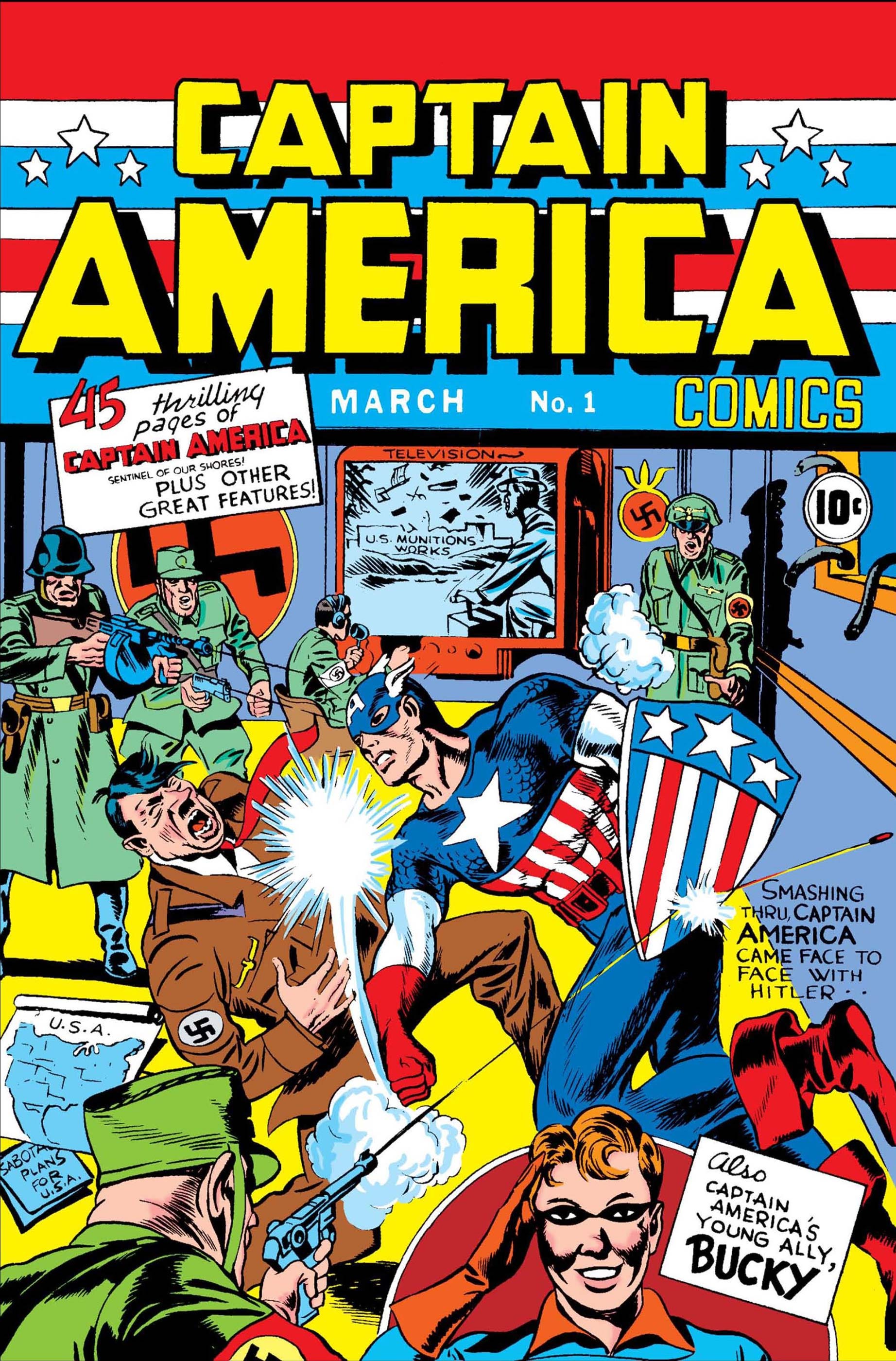
The story of Captain America is the story of a puny little guy named Steve Rogers.
Because Steve was too much of a little weiner, he was given 4-F status when he tried to volunteer for service. Still, he was determined to fight for the Allied war effort, so he signed-up to be the guinea pig for a secret giovernment program that was attempting to create a super soldier.
Years later, modern day comics would reveal that there was a dark Tuskegee Experiment-like side to the super soldier program, something I mention in my What if review, but at the time, Steve was the first successful test, intended to be the first in an army of soldiers enhanced to the peak of human physical perfection and beyond by an experimental "super-soldier serum.” Unfortunately for the Allied war effort, a Nazi spy interrupted the experiment, killing Dr. Abraham Erskine, the serum’s creator and the only one who possessed all of the serum’s secrets, and so, Steve Rogers was left as an army of one. Dubbed Captain America, dressed in a star-spangled costume, and carrying a virtually indestructible shield, he fought throughout World War 2, both at home and abroad.
Captain America quickly emerged as Timely Comic's most popular and successful wartime creation, and was also the first Marvel character to appear outside of comic books in the 1944 serial Captain America.
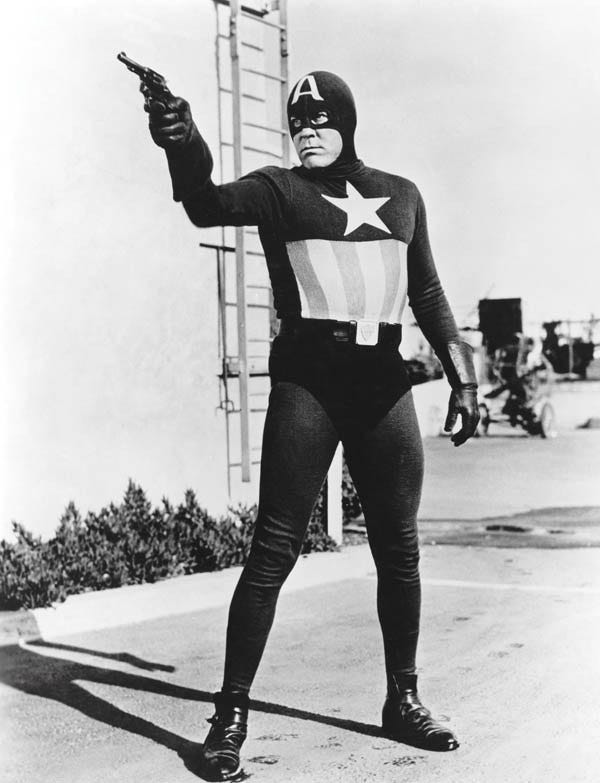
But like most of the comic book superheroes of the time, the public’s general apathy for WW2 themed stuff led to waning interest and flagging sales, eventually resulting in the character being shelved in 1950.
There was a short-lived revival of the character in 1953. This was eventually narratively retconned into being a Captain America pretender, a man driven mad by the bad batch of bathtub super soldier serum he used to gain his abilities, and this was done, not just because, when Captain America returned to comics in 1964, the story was that he had been frozen in the Artic ice in suspended animation since the end of WW2, but also because, looking back at the 1950s version of Captain America, with his rabidly virulent anti-communist agenda obviously rooted in both anti-semitism and racism, can be a little awkward when you’re talking about a character who is an idealist when it comes to the American Dream, not a jingoist.
The upside of all of that is that it resulted in the 1950s Captain America often returning as an antagonist to the real Captain America, narratively acting as a dark mirror of the soul of the very country that he represents.
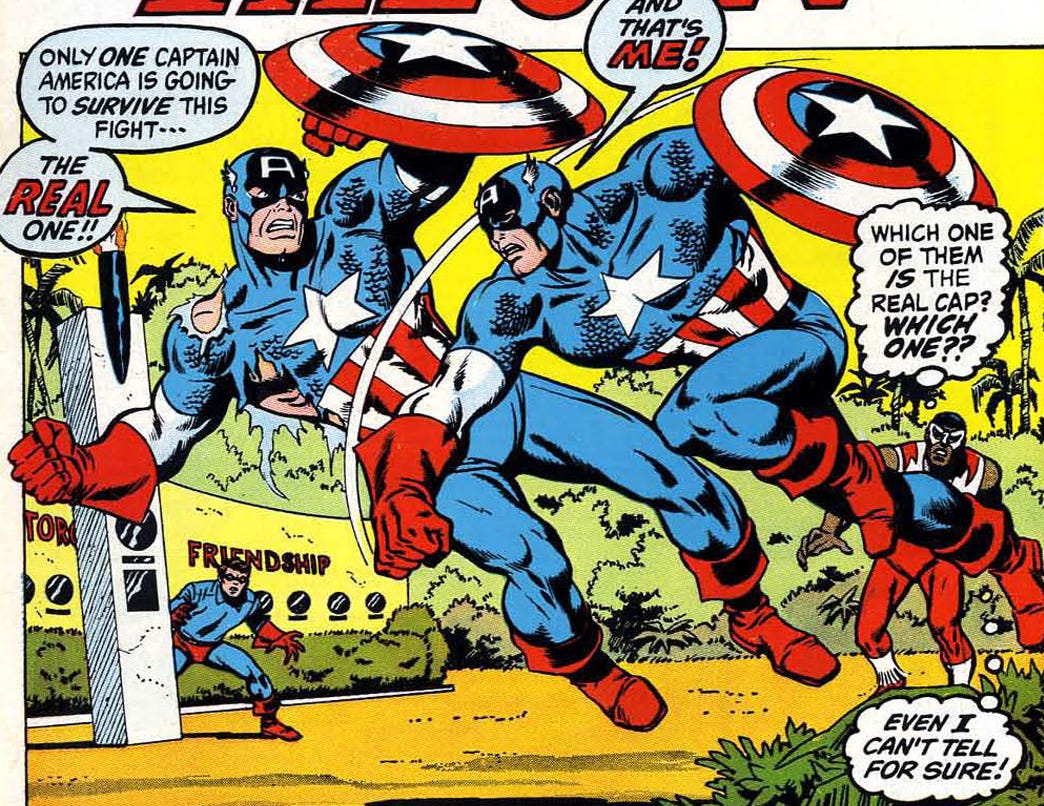
I also talked about this in my What if review.
So, for years, whenever I would visit my dad over the summer, there was this big cardboard box of my uncle’s old comic books. It was filled with old Justice Leagues (including the cross-over where they team up with the Justice Society, in order to find the Seven Soldiers of Victory, who had been lost in time), there were some Sgt. Rocks, Unknown Soldiers, Batmans, Spider-mans (including the issues where Green Goblin kills Gwen Stacy… or Spider-man does, depending on how you read it), some X-Mens, some Green Lantern & Green Arrow (otherwise known as the adventures of the hippy and the square), a sadly very beat-up issue of Silver Surfer #1, a few Inferior Fives, a few Flashes, a few Haunted Tanks, and a few Nick Fury and the Howling Commandos, there were lots of Supermans too, as well as the adventures of his girlfriend Lois Lane, and his pal Jimmy Olson, not to mention a bunch of Marvel Triple Actions, a couple Defenders, and a lot of Avengers. But mostly, it was a lot of issues of Captain America and the Falcon. Every summer I would haul that box out, separate the pile of comics into a bunch of smaller piles of all the specific titles, then put each group in numerical order, then restack them, with the titles in alphabetical order, and settle in for the summer to read them all.
It was a ritual.
These comics were not just my introduction to superhero comics in general, and their weird worlds of tights and capes and swashbuckling derring-do, they were also where I first read about the death of Captain America’s wartime partner, Bucky.
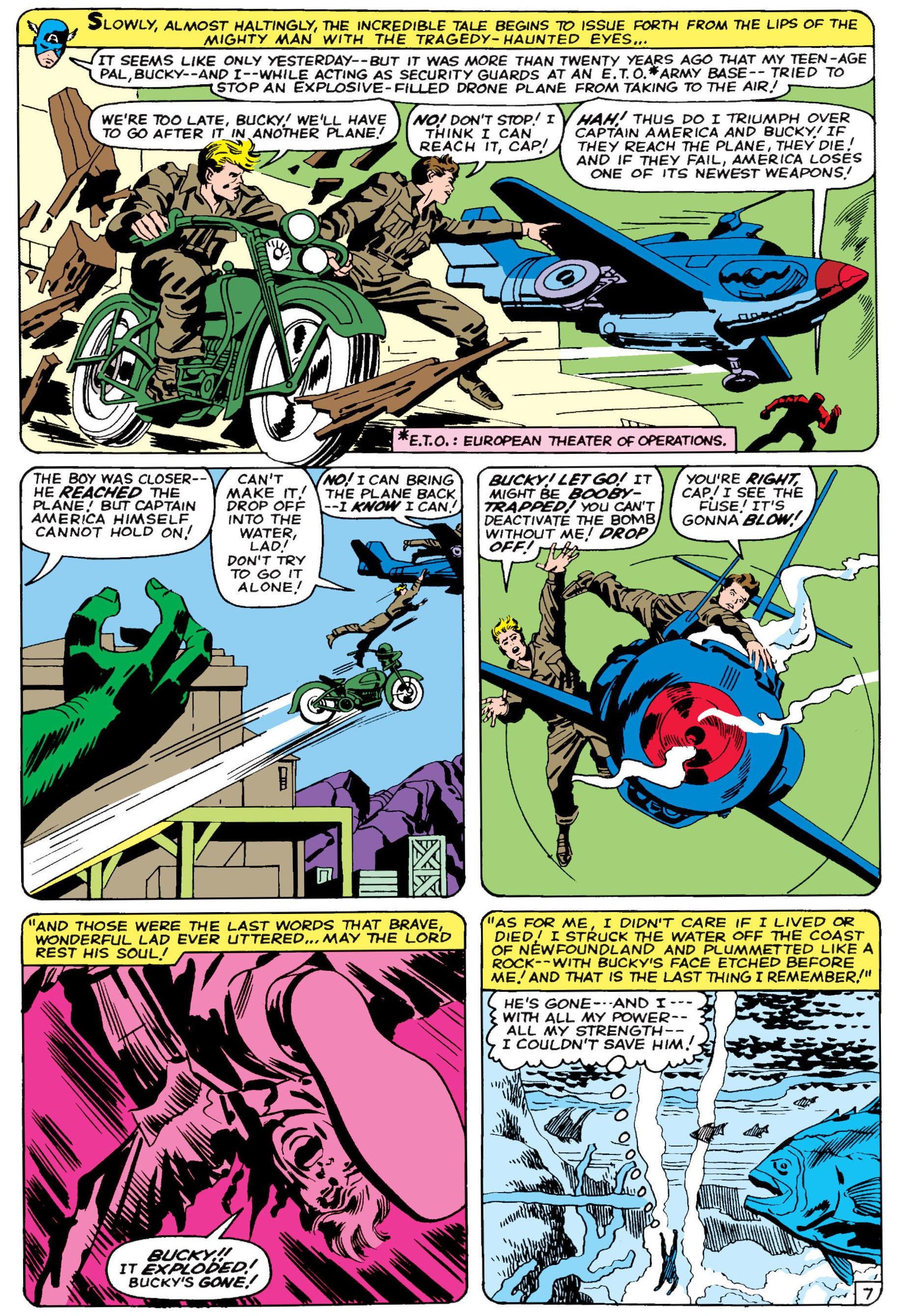
It exploded! Poor Bucky.
As I mentioned, Captain America returns to comics in 1964. In Avengers #4, Namor, the Submariner, finds a bunch of native people worshipping a frozen figure encased in ice, and because Namor never misses a chance to be a dick, as mentioned in my Black Panther Wakanda Forever review, his immediate reaction is: “Fuck your Gods,” and he hucks the frozen figure way out into the ocean, and then I assume, gives the native people a double middle finger, and dips out.
BUT…
That frozen figure is actually Captain America, and as the ice slowly floats south, slowly melting… fate has it cross paths with the Avengers’ submarine, while the team is out trying to track down the Hulk, who had just gone on a rampage in New York City due to the meddling of Loki.
The cliffnotes…
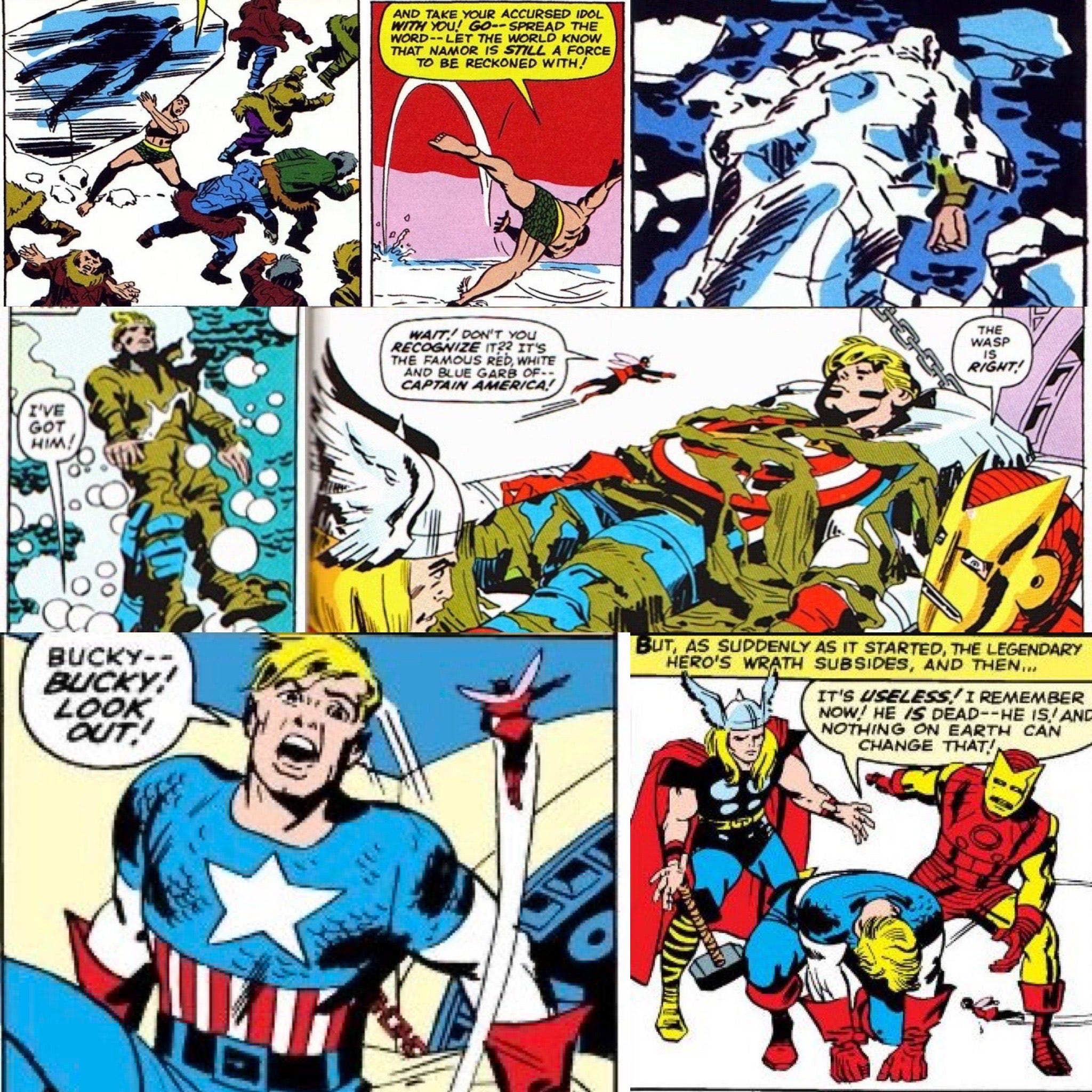
And that is how Captain America returned to the modern superhero world.
Frequently struggling with both his status as a “man out of time” as he attempts to adjust to the modern era he finds himself in, as well as the trauma and survivor’s guilt resulting from Bucky’s death, Captain America goes on to become not only the leader of the Avengers, but a mainstay of the Marvel Universe, and has remained in continuous publication ever since.
This includes Avengers #56, published in 1968, one of my favorites from that old box of comicbooks. I think it originally intended to try to put a cap on the story of Captain America’s grief due to the death of Bucky, but in actuality, it may have served as some of the ground work for the eventual conception of the Winter Soldier storyline, which was then adapted into the movie. Additionally, this issue also highlighted the casual interconnectivity that is a hallmark of superhero comics in general.
And it was titled… Death Be Not Proud!

Duh! Duh! DUUUUH!
The issue opens rather dramatically with a strange quartet standing beneath the looming shadow of a foreboding castle. Giant-man (Hank Pym, the tall one), the Wasp (Janet Van Dyne, the woman), Black Panther (T’Challa, in black) and Hawkeye (Clint Barton, the other guy) are in Latveria, the country ruled by the villainous tyrant, supervillain, inventor, sorceror, and all-around jerk… Doctor Doom!
They’ve been summoned here by Captain America for mysterious reasons…

Even better than Cap biting his fist dramatically, I love how Hawkeye apparently has no fucking idea where they are, or why. He just got on the quinjet, and flew across the world, zero questions. “What’s that? We’re going somewhere to maybe beat the crap outta someone? Sounds awesome. Can I finish my hot dog? …No? Okay… Let me just go get my bow and arrow then. Jarvis? Clean up this hot dog!”
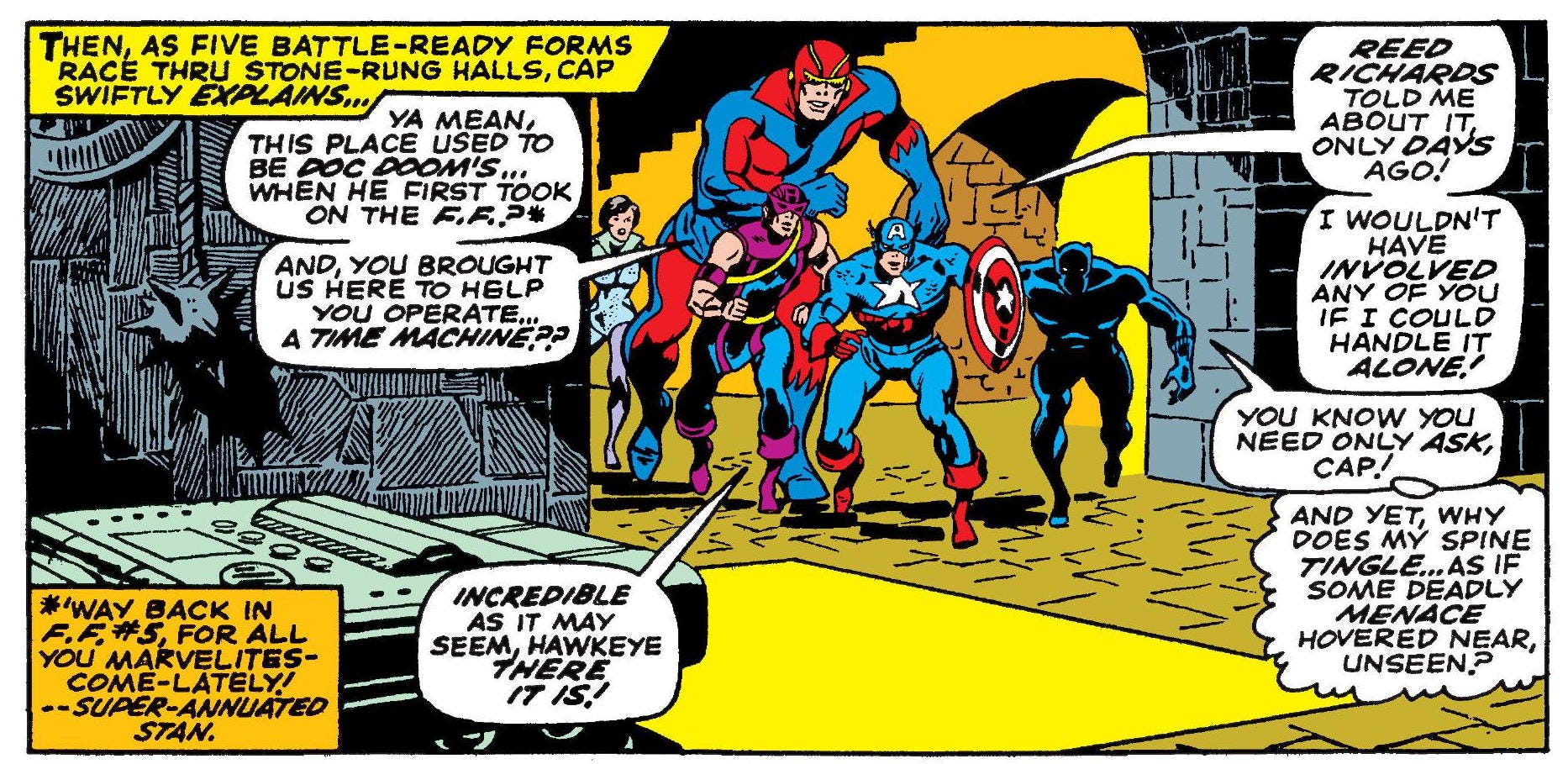
A lot of modern day comicbook “fans” complain about how “wordy” modern day comics are, but look at that shit! Word balloons just devouring these panels, and these are blown up too, they were even smaller panels on the page originally!
Also, I love how Dr. Doom’s Time Travel Machine is just there in his castle. The Fantastic Four had just recently had a whole bunch of trouble because of that thing, and then afterwards, they just left it there? Reed Richards apprently going: “What am I, the Timepad police? Fuck you.” then just walked away, leaving the castle doors wide open. Sure, there’s a booby trap or two, but still… the Timepad works. All you gotta do is walk up, turn it on, and then do whatever you want.
That seems irresposible.
Anyway, the Avengers travel back in time to WW2, specifically to that fateful day of Bucky’s death and Captain America falling into the icy water, because Cap needs to know for certain whether or not Bucky could’ve possibly survived too. The four guys go, and leave the Wasp behind, most likely because she’s a girl and this is America, but also maybe because she almost immediately falls alseep on the control panel…
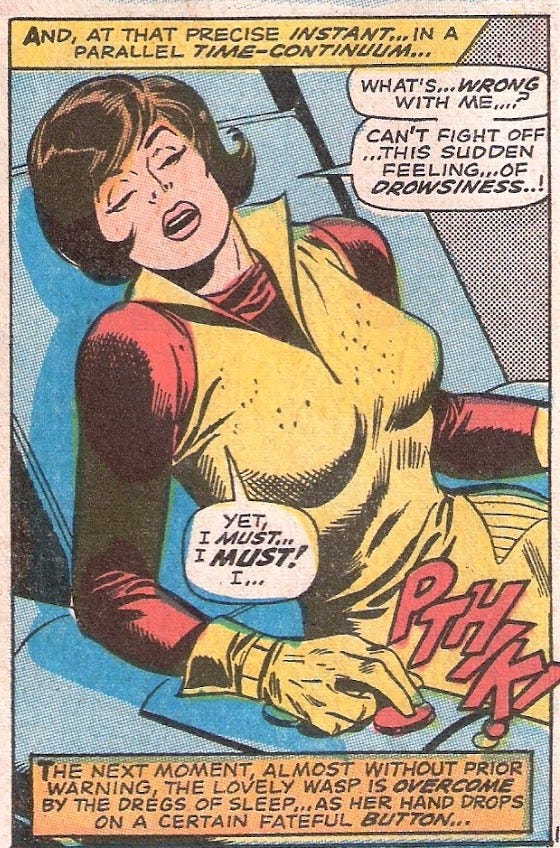
God damn it, Jan…

This mishap causes the Avengers to suddenly materialize in the past, finding themselves in a room with an unconscious Captain America and Bucky, captured by the evil Baron Zemo and some of his rat bastard Nazi henchmen, and for a brief moment, oh yeah… it’s on like Donkey Kong!
Four Color Fisticuffs Galore!
Eventually, the Wasp startles up from her nap-jerk, momentarily confused as she wipes the drool off her face and the control pad, and then hurriedly turns the switch off again, causing the Avengers to fade away, returning to the present. But at the last moment, Cap completes a Terminator-esque time-loop, throwing his shield before it vanishes, freeing his past self, so that he and Bucky can end up right were they’re supposed to be.
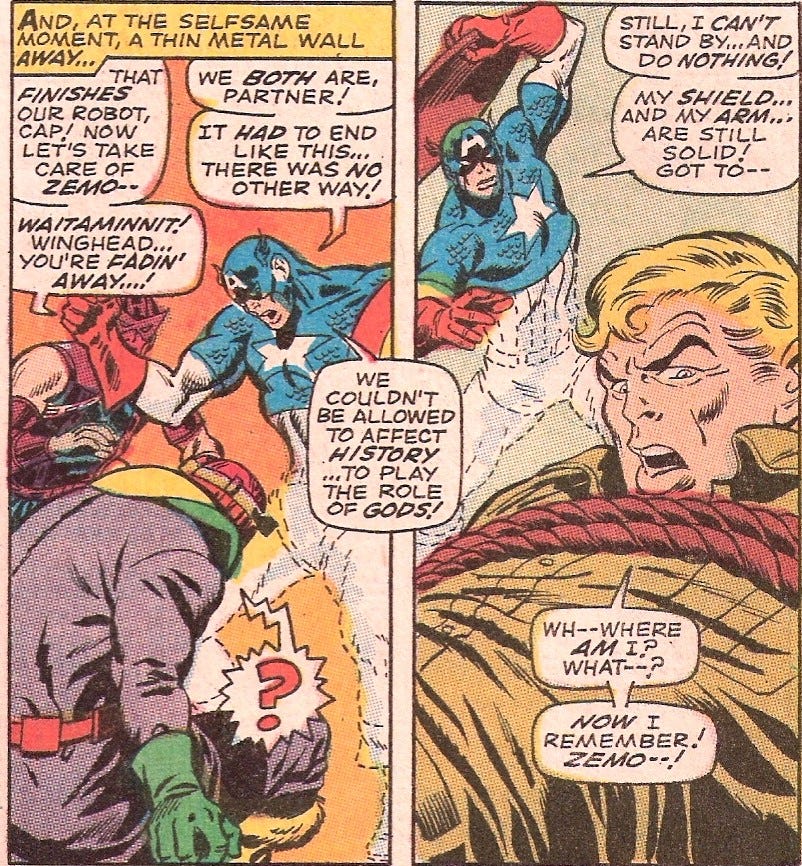
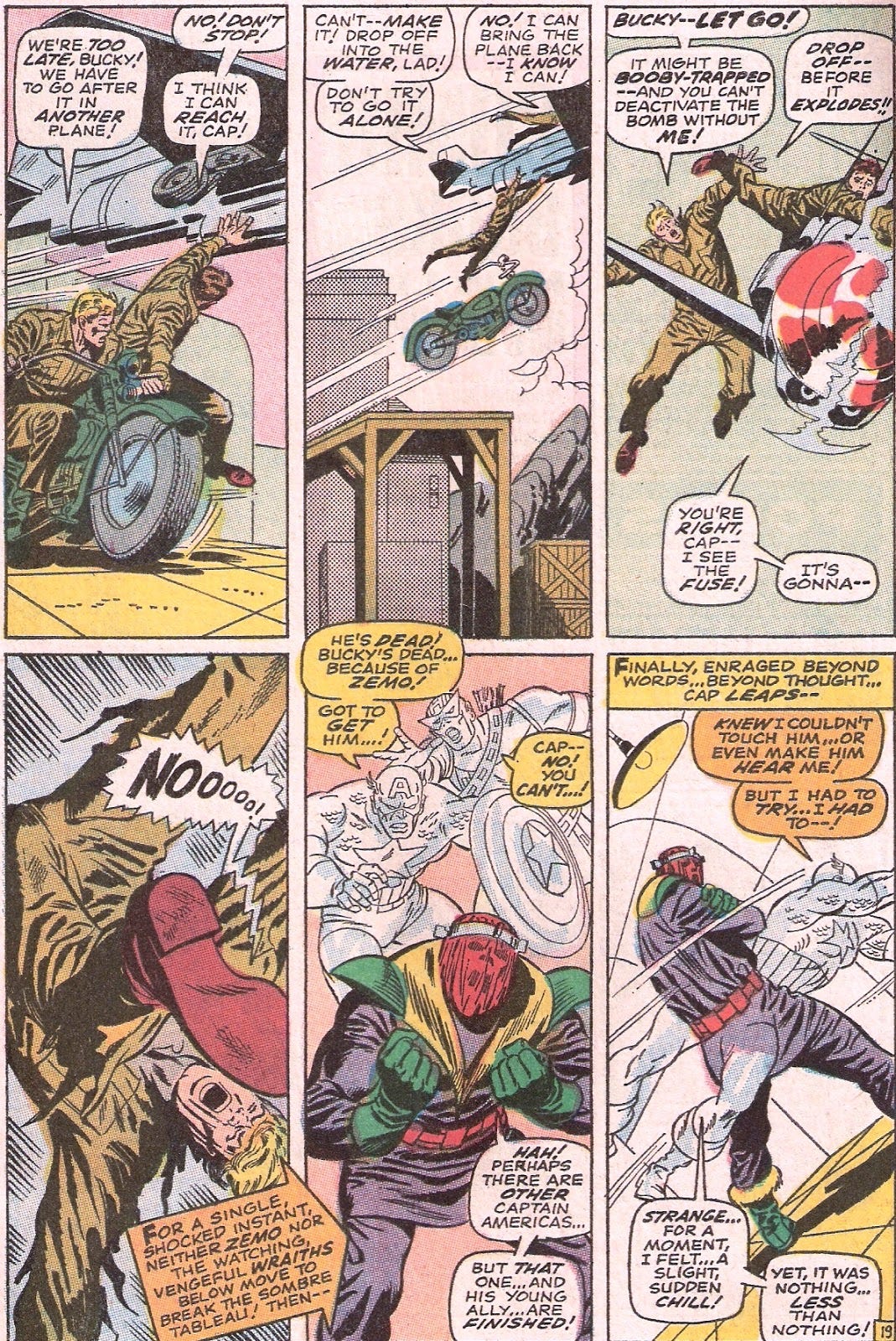
Time truly is a flat circle…
And thus, Captain America is forced to accept the cold hard truth, that while the future may not be set, and there is no fate but what we make for ourselves, the past unfortunately is, and Bucky is well and truly is dead.
Or is he…?
We wouldn’t find out for another 36 years.

Not now, Jan!
Marvel comics doesn’t do a lot sidekicks in general, that’s more a DC thing, like Batman and Robin, but Captain America is a bit of an outlier. And while he has had a lot of chastely-loved girlfriends over the years, he’s also had two main partners, and he loved them both very much. So much so, in fact, the question “is Captain America also secretly gay?’ is a fair one.
Marvel would never admit it, if true, and of course, and that’s something that is really at the whim of the specific writers, but… seriously, just watch these two movies, and then tell me what you think.
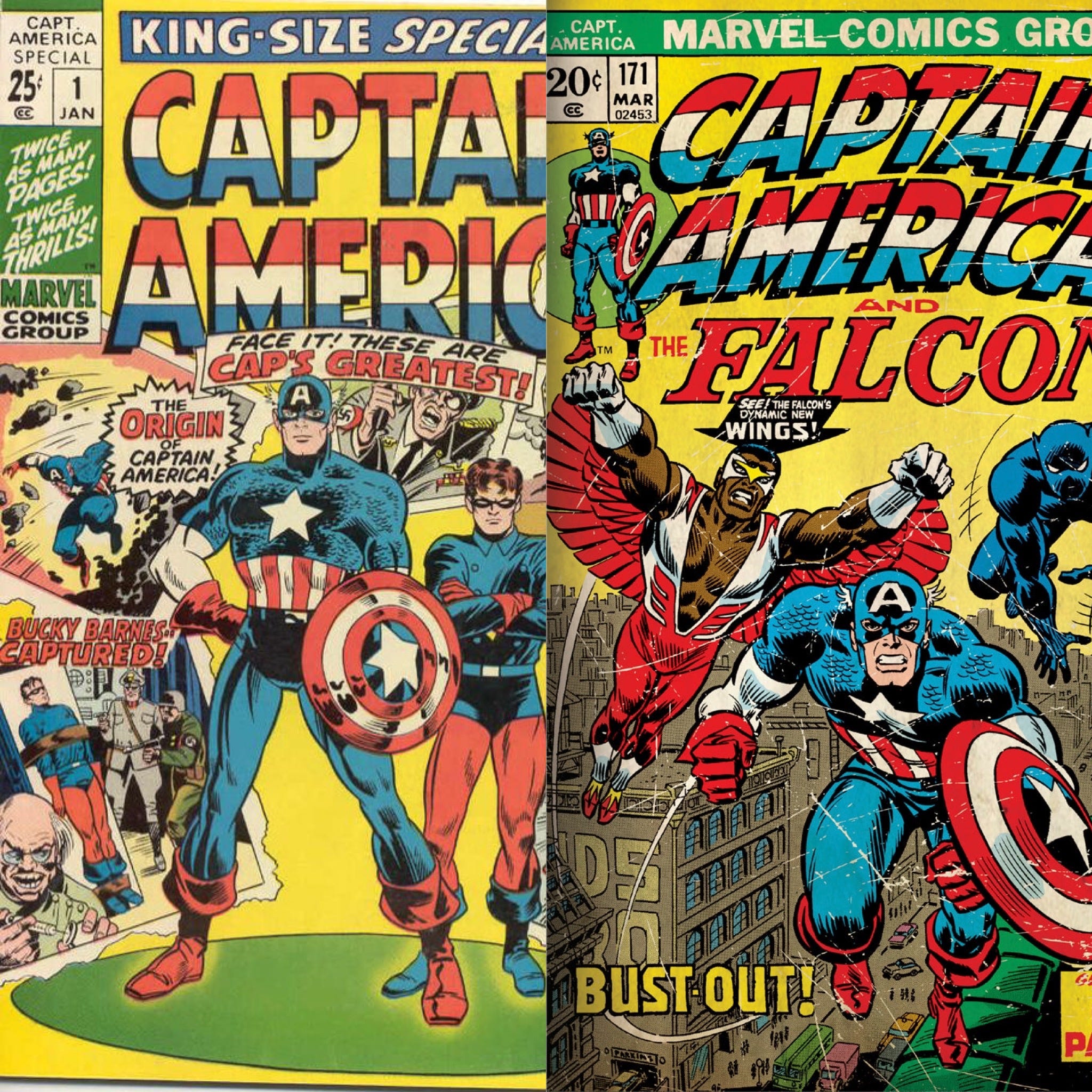
But I digress.
The first of Cap’s two main partners was…
James Buchanan "Bucky" Barnes
Originally introduced as Captain America’s kid sidekick to Captain America, Bucky was also created by Joe Simon and Jack Kirby, and appeared at the same time as Cap in Captain America Comics #1. And while a lot of different characters have worn a version of the Bucky costume, and have used the nickname, over the years, there’s really only ever been one.
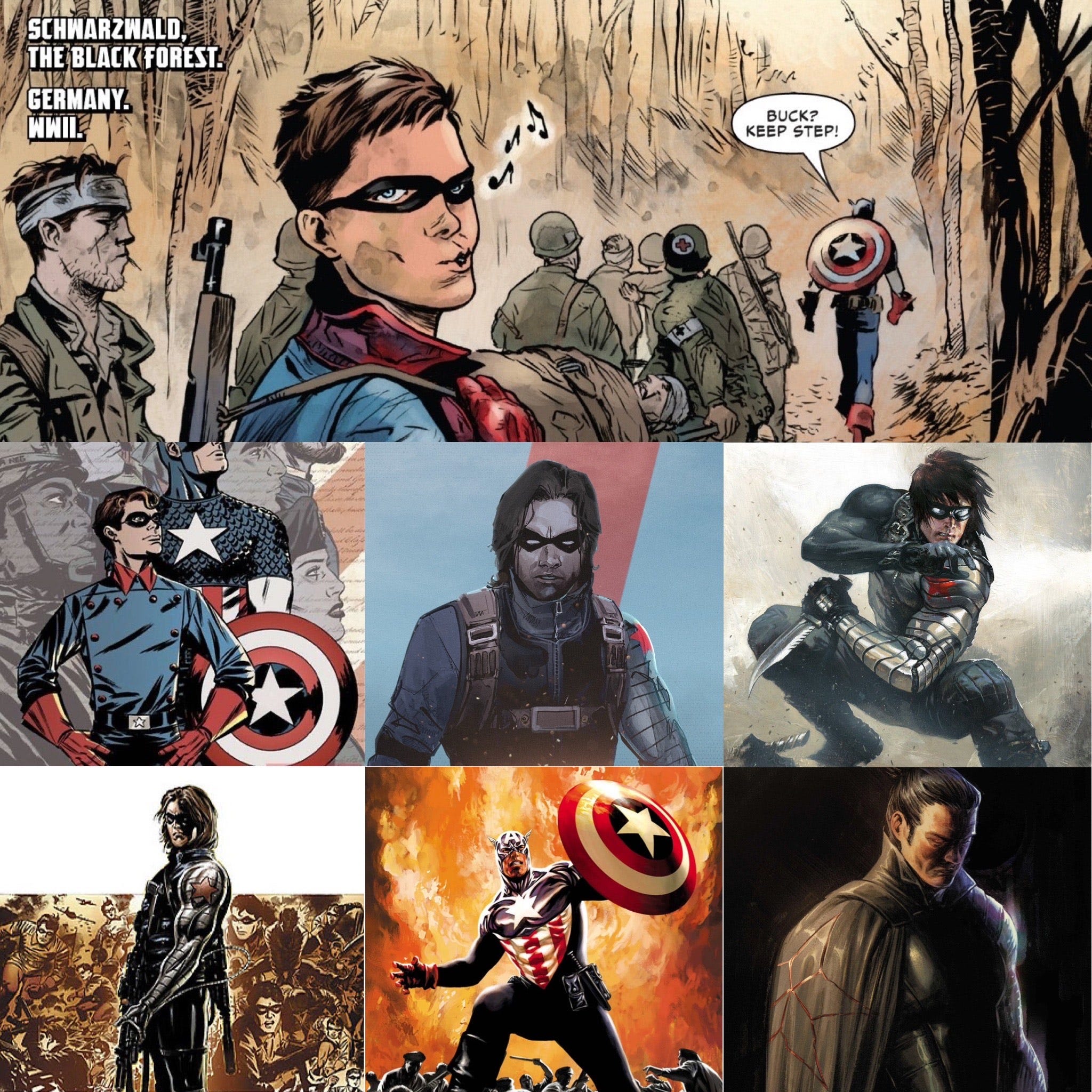
For years, there was an oft-cited rule in Marvel comics that was brought up whenever some weepy fan would get super upset over some character’s death: “Only Bucky and Uncle Ben stay dead.”
That was true for a long time, until 2014 when Steve Epting and Ed Brubaker resurrected Bucky as a brainwashed assassin cyborg called the Winter Soldier. They aged him up a lot too, and pretended like he was never actually a 12 year old boy that Steve Rogers dressed in bright colors and then took into combat in WW2, and seemed to get killed, but was actually a full grown man the whole time, a man who was, after that plane blew up, fished out of the North Sea by the Russians. They then turned him into a remorseless killing machine that they would keep on ice between missions, and he is now responsible for hundreds of Cold War related murders throughout the latter half of the Twentieth Century.
Bucky’s memories and personality were eventually restored after a whole lot of superhero bruhaha and Cold War rigmarole, and he then went on to briefly assume the mantle of Captain America when Steve was believed to be dead, but was actually unstuck and hurling though time. Currently, Bucky is wandering the Marvel Universe, a big sad boy/dark hero forever in search of redemption.
But for the many years when Bucky was believed to be dead, Captain America had another partner named...
The Falcon (Samuel Thomas "Sam" Wilson)
First appearing in 1969 in issue #117 of Captain America, introduced by Stan Lee and Gene Colan, Sam Wilson is the first Black American superhero in mainstream comics, and is named after the man who is purportedly the source of the personification of the United States known as Uncle Sam.
As of 2015, he is also now the offical Captain America.
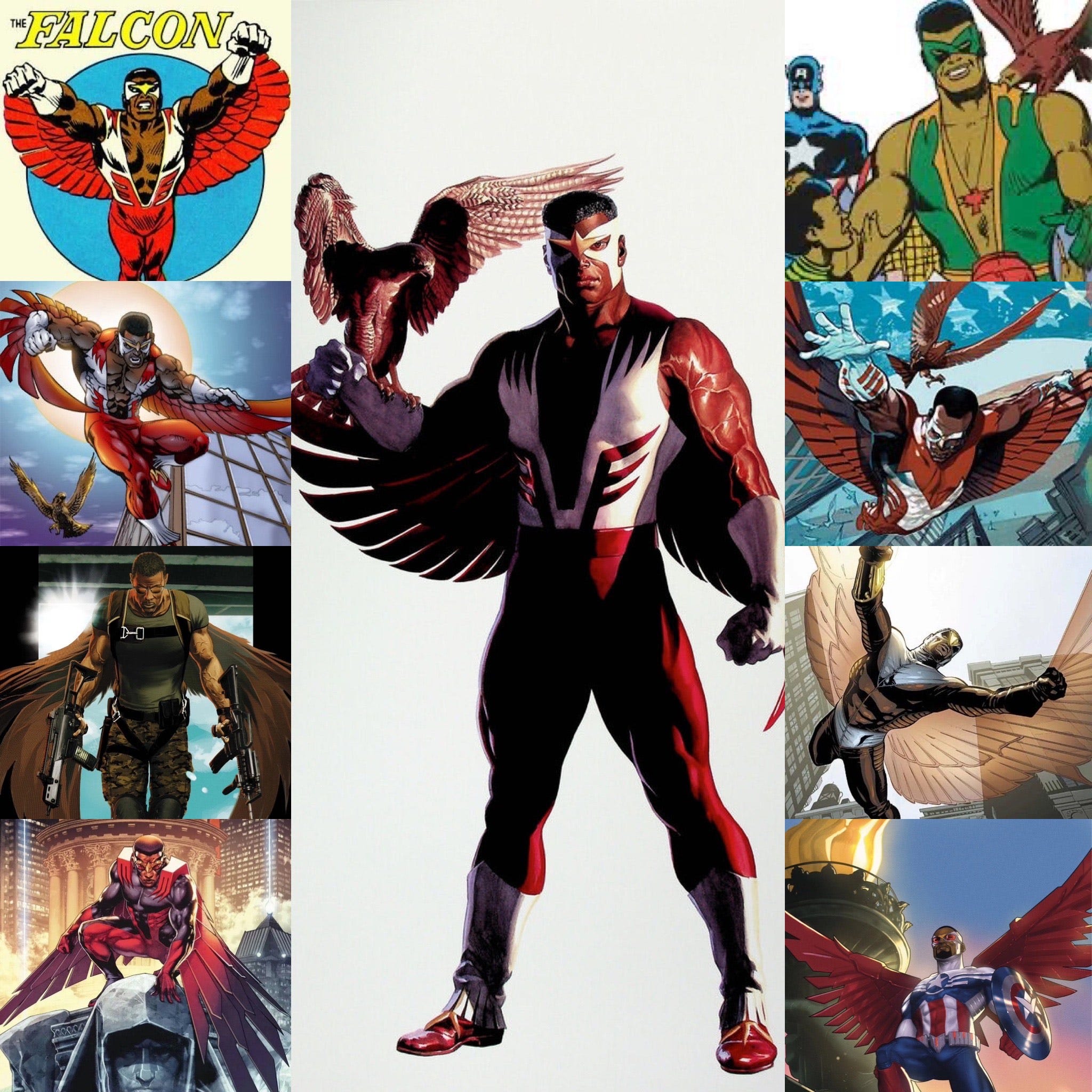
While he inexplicably had no wings when he was first introduced, and used a wrist gauntlet that fired a grappling hook shaped like a falcon’s claw that he then used to swing around like Spider-man instead, the Falcon now uses mechanical wings to fly. He also has a falcon of his own named Redwing, and depending on the era, he can not only communicate with it, but with all birds in general.
Throughout most of the 1970s, the Falcon and Captain America were a team operating out of New York City in a comic called Captain America and the Falcon. There was a lot of espionage and Cold War stuff, and a deliberate effort to talk about societal issues, like fascist threats to democracy, or systemic racism in America. It was still a comic book, sure, so it’s not like it was super deep or anything, but that was still the intent, and that intent was reflected in the movie adaptaions too.
Finally, while Captain America’s comics were usually a boys’ club… they often let a couple of girls hang out too, girls like…
Black Widow (Natalia Alianovna "Natasha" Romanova)
Created by Stan Lee, Don Rico, and Don Heck, the Black Widow debuted in Tales of Suspense #52 in April 1964. Initially a Russian spy, and an antagonist of the superhero Iron Man, later revealed to have been a recipient of a knock-off Russian version of the super soldier serum, as well as a graduate of a Russian program that molded orphans into assassins where she trained with the brainwashed Bucky, Natasha eventually defected, became an agent of S.H.I.E.L.D., and a regular member of the Avengers.
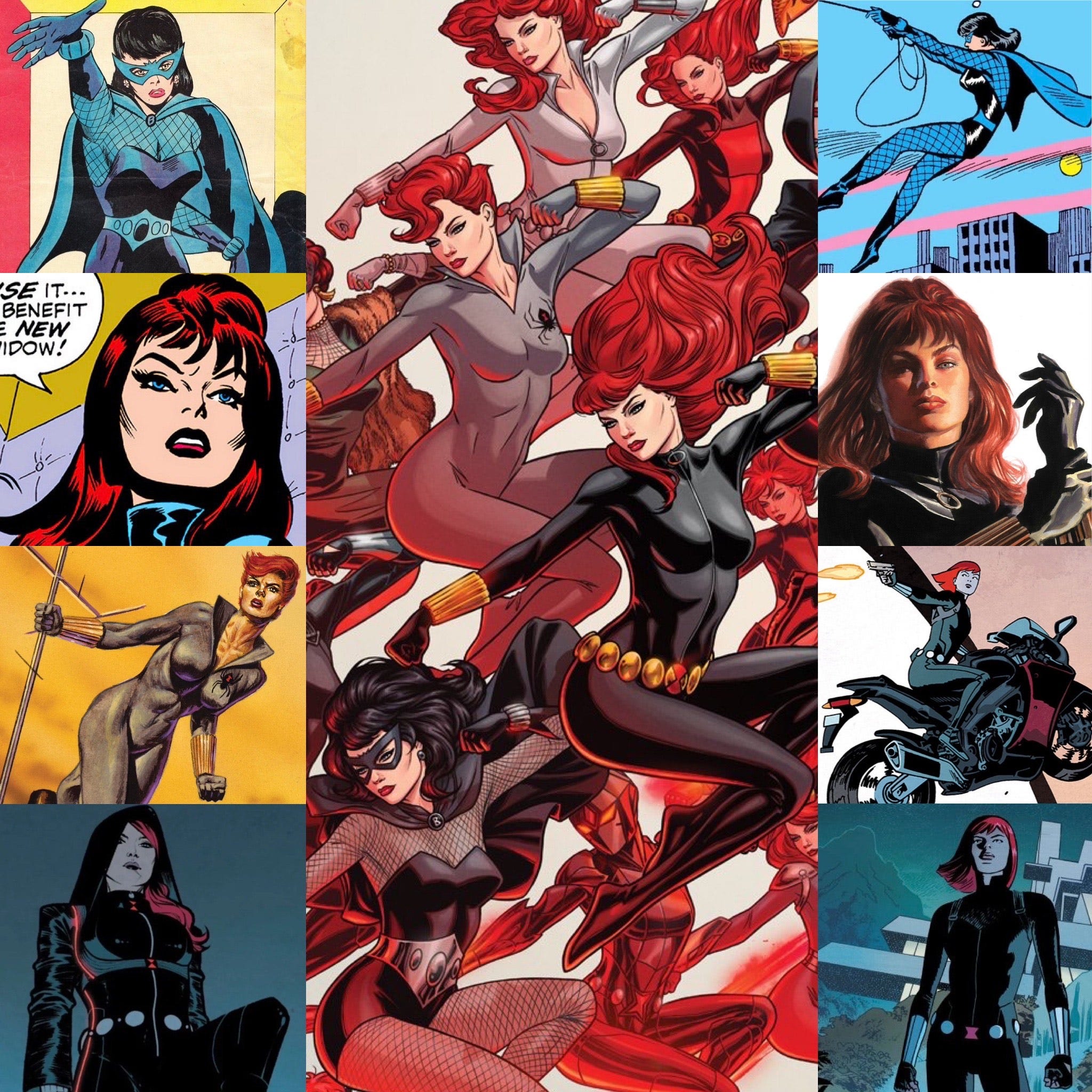
Initially introduced in a ridiculous short cape and blue fishnets outfit, the Black Widow was updated in 1970, when she was reintroduced in her now more familiar look of shoulder-length red hair, a skintight black costume, and wristbands which fired both grappling lines and stinging blasts. I always assumed this look was based on Mrs. Emma Peele from the british tv show The Avengers, as she debuted in October of 65, but…
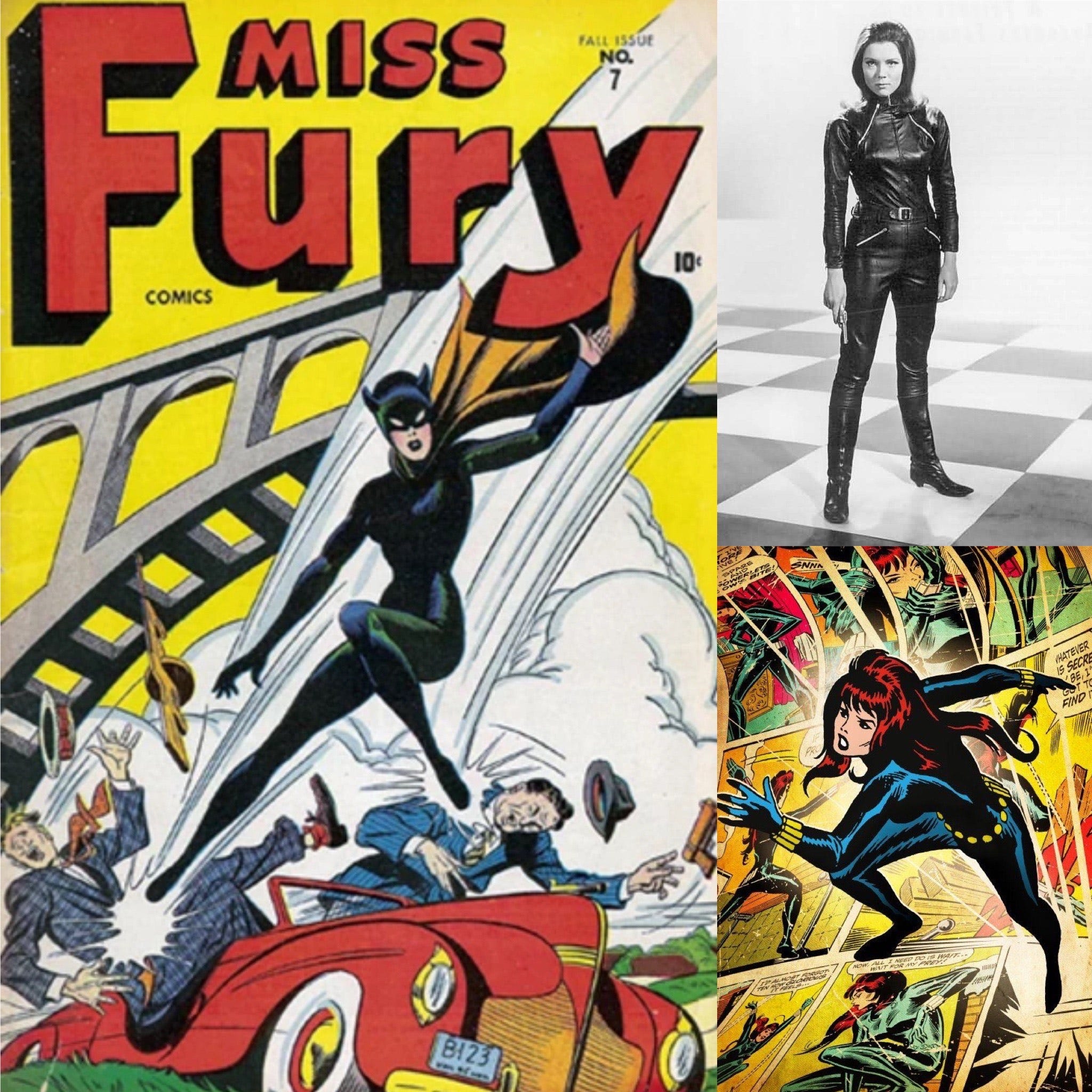
John Romita, the artist responsible for the update, has said that it was based off Miss Fury, a pulp-era character from the 40s. Miss Fury was a wealthy socialite by the name of Marla Drake. She had no powers, but she gained strength and speed when she wore her special skintight catsuit made of panther skin that was “used by an African witch doctor in voodoo ceremonies.” She was also often accompanied by an albino Brazilian character named Albino Joe. So, yeah… she doesn’t get mentioned often these days, but hey… at least she fought Nazis.
Anyway, Black Widow was one of those characaters, like Spider-man, whose entire existance was a regular reminder of the casual interconnectivity of the Marvel Comics Universe, as she not only regularly hung out with Iron Man, Captain America, and in the worlds of both the Avengers and SHIELD, but she also regularly appeared with Hawkeye and Daredevil too.
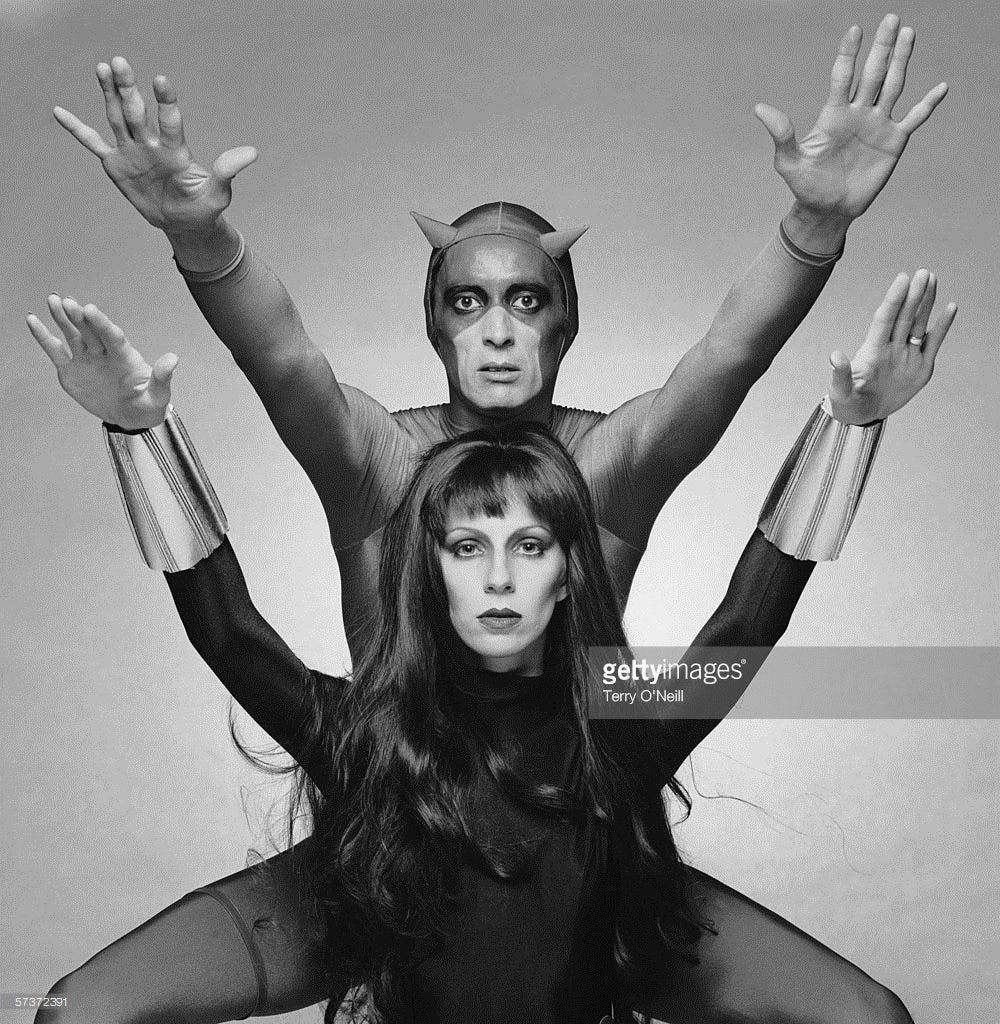
Also, in 1975, Angela Bowie, then wife of David Bowie, managed to secure the TV rights to Daredevil and Black Widow, intending to do a series. Bowie himself took a series of pictures of her as the Black Widow, and actor Ben Carruthers as Daredevil, for her use to shop the project around to producers, but alas, it never came to fruition.
Just fyi…
I mention all this nonsense, not only for the general background, and the fact that these kind of nerd-outs generally don’t go over well in real life at adult parties, but also because one of the main complaints about these movies from “fans” is how they don’t focus on just Captain America, and instead feature a bunch of other characters too, so what I’m saying here is… That’s how it’s always gone in the world of Captain America… it’s always been cheek to jowl with the greater Marvel Universe, so it only makes sense that in the movie version Iron Man, the Black Panther, Spider-man, Ant-Man, Vision, Hawkeye, Scarlet Witch, War Machine, and so many others, especially Nick Fury, would show up too.
And with that, the movies in question…
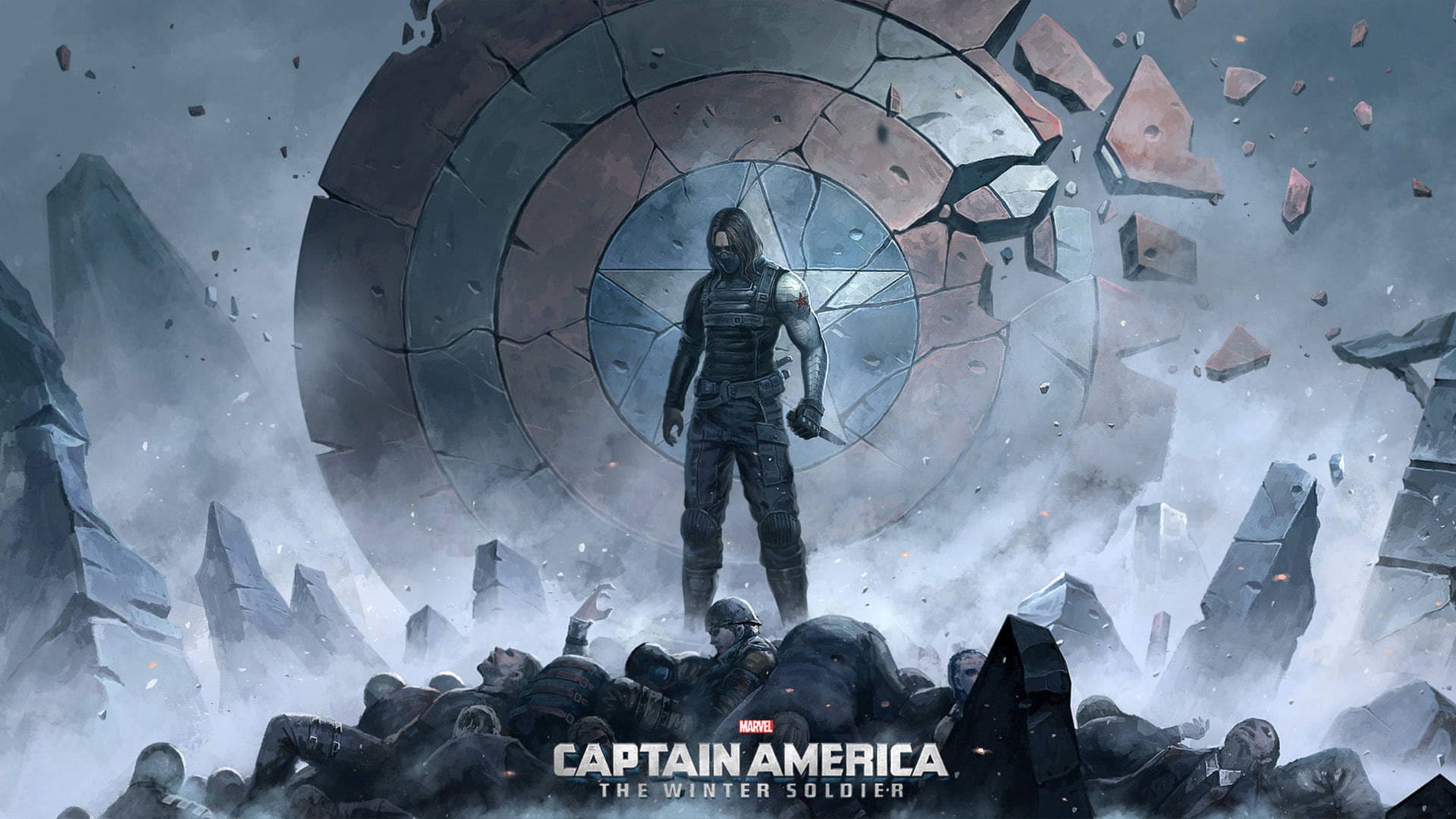
Captain America: The Winter Soldier
Hail Hydra!
After turning back an alien invasion led by a rogue God, alongside his fellow Avengers, Steve Rogers, aka Captain America, is now living in the nation's capital, trying to adjust to modern times. He is quietly working with The Strategic Homeland Intervention, Enforcement, and Logistics Division, known to the world at large as S.H.I.E.L.D., in order to defend the country from all threats, foreign and domestic. But when an attack on Nick Fury throws Rogers into a web of intrigue, placing the whole world at risk, he must join forces with the Black Widow and a new ally, the Falcon, to expose an ever-widening conspiracy, one with very deep roots, only to discover an unexpected enemy standing in his path.
To me, everything about this film is done absolutely right.
I’m not trying to claim that it’s the greatest film of all time or anything, but as a long-time Captain America and the Falcon fan, this film hits every note that an adaptation needed to hit, and it does it perfectly.
I had a few problems with the first Captain America film in 2011. While I did appreciate large parts of it, and the USO Tour in particular was magical, it still didn’t quite hit right for me, especially as a person who read old Howling Commado comics. My main issue with the film is probably best illustrated in how Director Joe Johnson decided that Captain America would only throw his shield on a few special occasions, and that’s just a fundamental misunderstanding of an integral part of the character. One of the best parts about Winter Soldier is how, right away, it’s clear that there is no such misunderstanding here. In this film, Captain America is truly a super soldier, and he’s just whipping that shield around like a god damn frisbee, ricocheting it off walls and bodies, and it always returns to him like a boomerang.
Does the shield defy physics? Yes, Sir Isaac Newton, it does, way to notice.
That’s not all it gets right either, there’s the classic Cap on a motorcycle, and the shield on his back, and his inspirational speech appealing to the S.H.I.E.L.D agents’ sense of duty and honor. Steve’s lonliness in this new world. There’s a perfect homage to Cap falling into the icy water at the end of World War 2 too. The film knows the character, and his world.
And not just with Captain America either. There’s things like the “On your left” gag with the Falcon, or Widow’s concern that Steve’s been hiding from the world behind his mask and shield, something she recognizes from experience, and how she tries to get him to start dating again. Cap resists, of course, as he carries a torch for Peggy, who he loves almost as much as he loves Bucky.
There’s so many pieces that fit just right.
I loved that not only is Three Days of the Condor is an obvious reference, but Robert Redford actually has a role. Although admittedly, I thought for sure that he was going to pull his face off and turn out to be the Red Skull, a classic beat the film missed. I also loved that S.H.I.E.L.D. was so heavily involved, as that organization has always been a big part of Cap’s world, and has also always been kinda shady too. Plus, there’s all the classic villains too, Hydra, Crossbones, and even Batroc the Leaper. Besides the return of the Skull, the only thing really missing was the Serpent Society.
And maybe Capwolf.
I absolutely loved the reveal of Armin Zola and his robot camera head too. This was not only a perfect use of such a classic weirdo of a characater, but the fact that Zola had wormed his way into S.H.I.E.L.D. as a result of Operation Paperclip, which was the U.S.’s real life effort after WW2 to grab as many Nazi Scientists and their work as possible before the Russians could. In the real world, this effort included people like Wernher Von Braun, who was a member of the Nazi Party, and was not only in charge of the planning committee, but he was also in charge of quality control at the Nazi Mittelwerk, which used slave labor from the Mittelbau-Dora concentration camp to produce V-2 ballistic missiles, which were the basis for not only our own ballistic missiles, but for the Saturn Rocket too, the lift-off engine that was instrumental in getting us to the moon. Von Braun even appeared in several Disney specials aimed at children of the Cold War era, which you can find on Youtube, where he talks about the future of space travel.
He was practically an American institution…
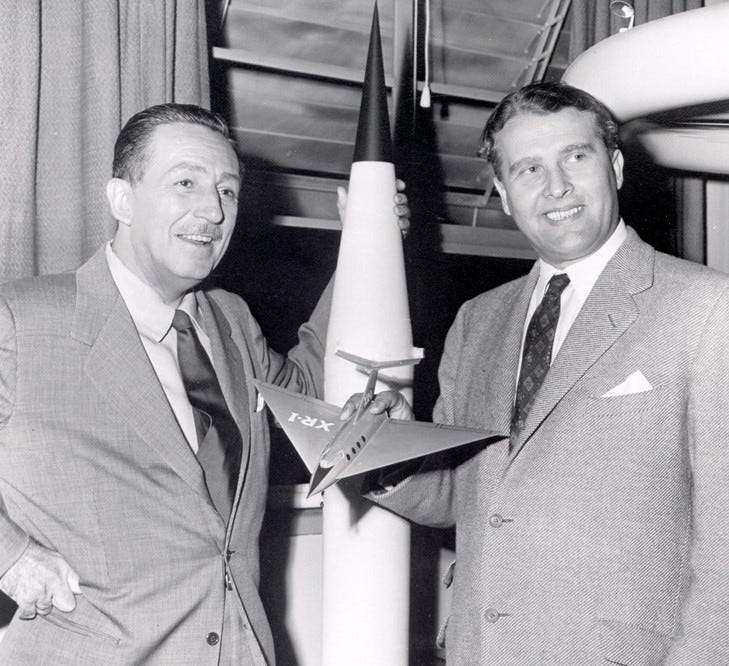
That the Winter Soldier weaves this ugly real life history so deftly into it’s own fictional history, exposing it as corrupt and irrefutably bad, and then has its hero face that legacy head on, and smash it to pieces… is not just really great in and of itself, it’s totally a classic Captain America storyline, a character who can always be counted on not just to stand up for what’s right, while putting himself out front and in danger to do so, even when it’s the very institutions that his entire personification is supposed to represent, but this is something that he has done multiple times throughout his comic book career. Cap has resigned, broken laws, and has been an outlaw just as often as he’s been a protector of law and order.
Best of all, both costumes are just fantastic. Not only do they look great, and strangely practical, at least from an in-world point of view, but they also clearly illustrate the two worlds that Captain America exists in.
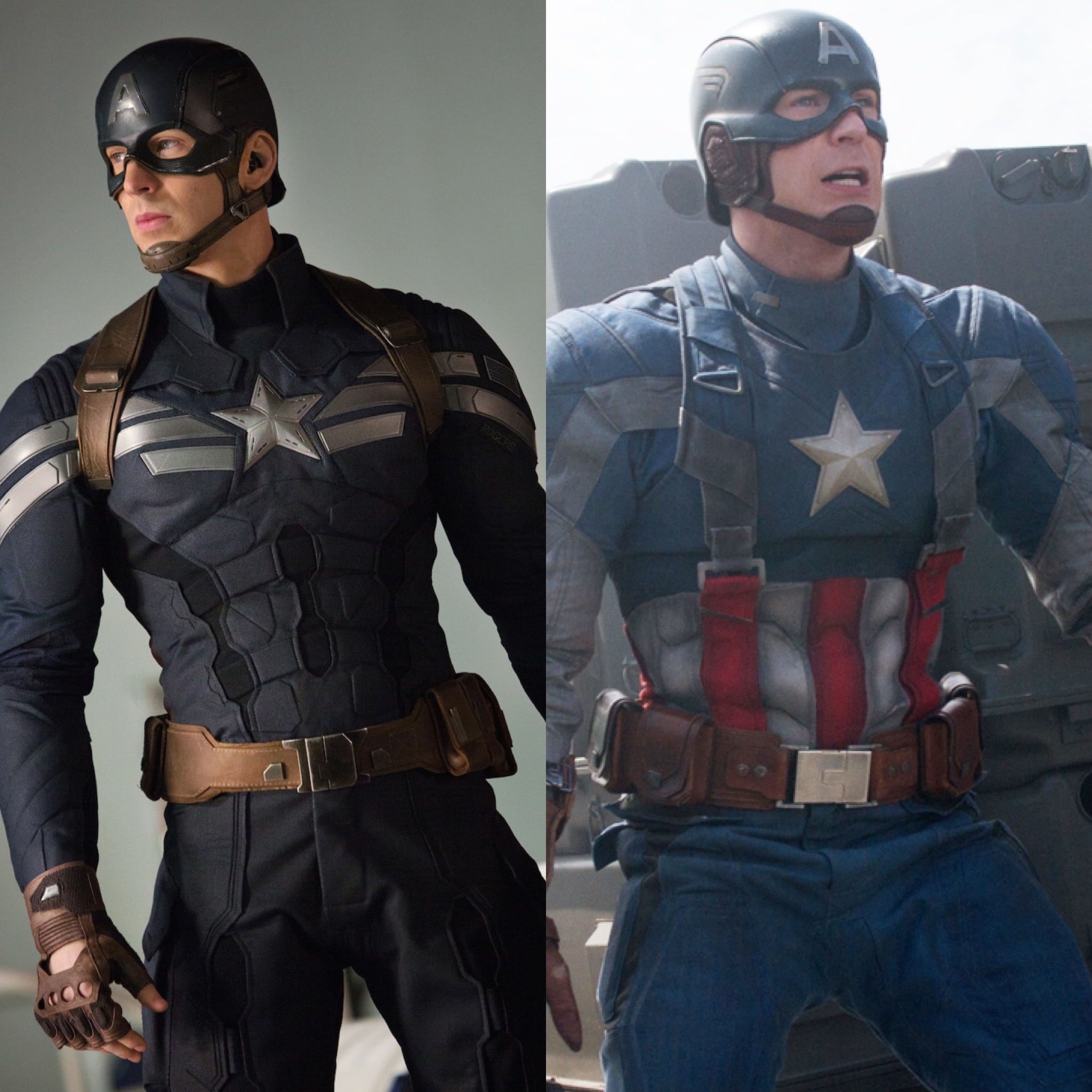
I also liked the little detail of how his shield is often dusty and scuffed up throughout the film, reflecting how Cap has found himself in a complicated and murky world, and its only clean again when his objectives finally becomes clear, and he realizes that he needs to take out both Hydra and S.H.I.E.L.D..
But all that having been said, overall… this film is just a straight-up blast. It moves quickly, but never too fast. Right from the start, the film brings the thunder, and then it’s just an even pace of awesome action set pieces, all hung off a framework of solid character work. The cargo ship raid. Fury’s street ambush. The Winter Soldier’s first appearance. The Winter Soldier’s second appearance at Cap’s apartment. The elevator fight, and the escape from the Triskelion. The Winter Soldier’s third appearance on the freeway, where he and Cap finally fight one on one, and Cap finds out that the man behind the Winter Soldier’s mask is none other than his old pal Bucky. All of which leads up to the assault on the Triskelion and the helicarriers.
Start to finish… it’s just good stuff.
Although, I do have to say that the glass domes on the bottom of the helicarrers, the structures that house the very important computer systems that run the automated weapon systems… that seems like a design flaw.
Also, while Natasha plays the role of female friend of Captain America in this film, Sharon Carter shows up too, although it’s mostly an after thought character. Sharon Carter is the neice of Cap’s WW2 girlfriend, Peggy Carter, and has long been Cap’s modern world main squeeze in the comics, which is kind of weird and gross, right? Especially because Sharon supposedly looks just like Peggy. I’ve never understood that motivation behind this particular character’s design.
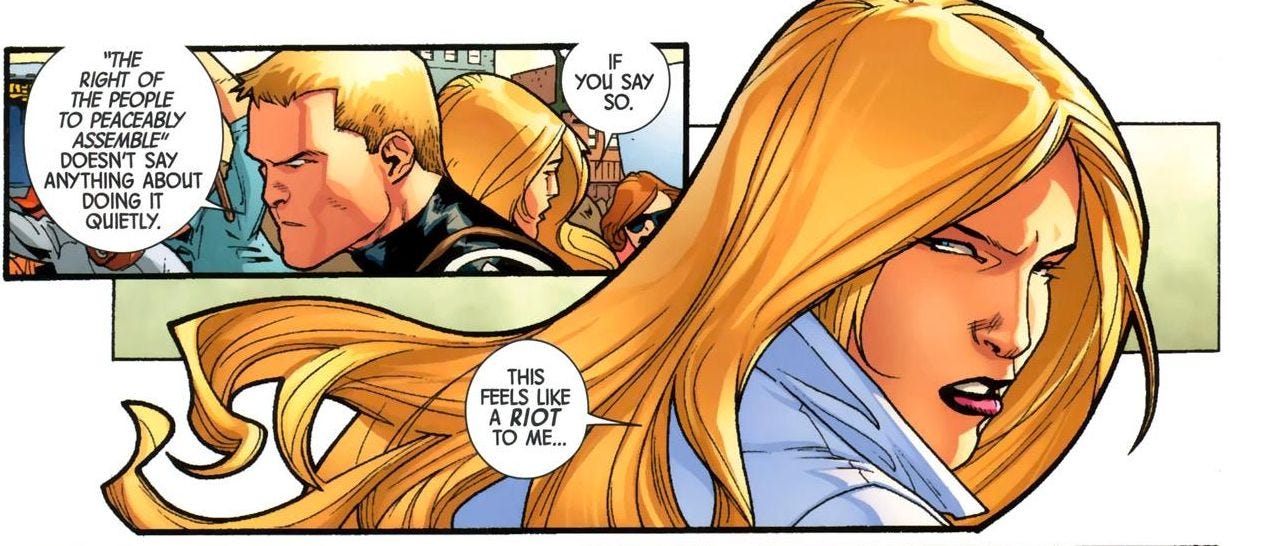
Personally, I’ve never liked her.
As a final sidenote on this one… you sometimes run into a certain type of pathetic little weirdo online, someone who bristles at Steve Rogers and Sam Wilson’s friendly ribbing in the opening of the film, where they lay the foundation of their friendship. This kind of person isn’t common, but they are strident, and they reveal so much of their own personal issues loud and clear when they accuse Cap of “bullying” Sam in this scene, and whenever you happen to see one of them posting this kind of nonsense somewhere online, it is just the saddest thing ever.
But I digress again…
In the end, for me at least, this is a great movie.
I love it.
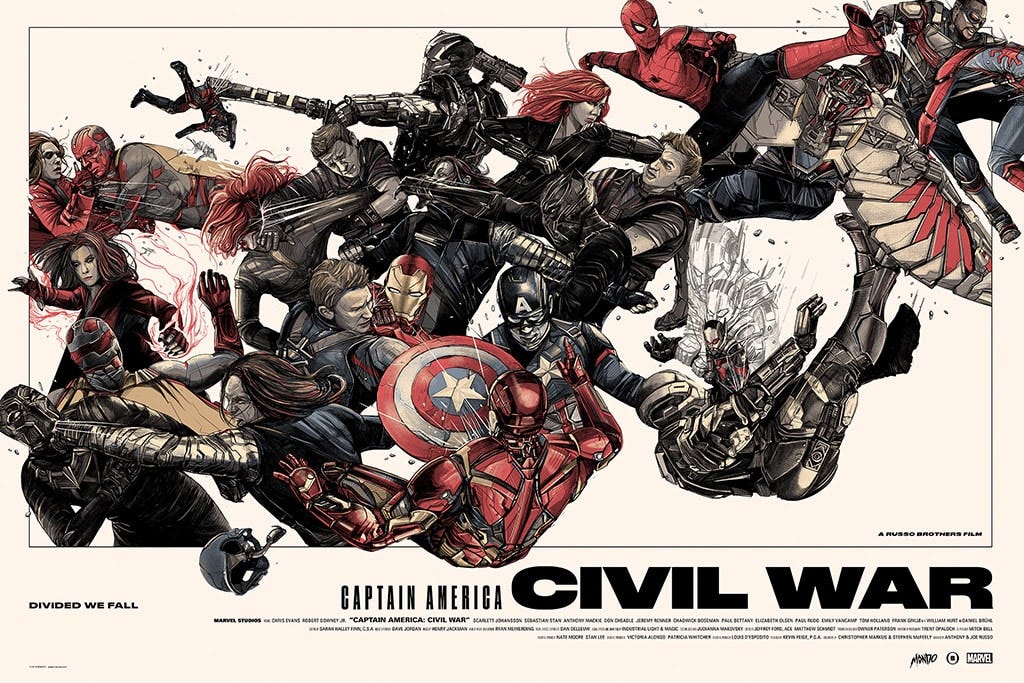
Captain America: Civil War
When Titans Tussle!
As the body count and the property damage piles up following an alien invasion in New York City, an attempted Nazi coup in Washington D.C., and a near-extinction level event at the hands of a genocidal robot in Eastern Europe, the growing political pressure to install a system of accountability for the Avengers builds to a head.
Then, when an attempt by the Avengers to capture a rogue team of villains results in the death of Wakanda citizens, bad change is inevitable, especially when a summit of world leaders convening to discuss the problem exposes the King of Wakanda to an assassin’s bomb. When it’s revealed that Bucky, still being controlled as the Winter Soldier, may be responsible for the assassination, the Avengers splits in two, one side following Captain America, wary of government control of their abilities, and wanting to save Bucky, the others following Iron Man, too aware of the death and destruction they have caused in the world to ignore it, not to mention the fact that if they don’t act now, someone else will, and it will be even worse for them. Soon, the debate devolves into all-out war, especially when a vengeful Wakandan prince enters the fray… as the Black Panther.
In the comics, the Civil War storyline was a massive line-wide cross-over that happened in 2006 and 2007. It turned on the same basic idea as the movie, exploring the conflict between freedom and security.
The story in the comicbook goes like this… after a recent mass jailbreak leads to a surge of supervillainy, and the clash that happens when a volunteer superhero team raids a supervillain safe house, all while being filmed for their reality show, resulting in a supervillain with the power to explode blowing up an elementary school as he tries to avoid capture, killing not just the supervillains, the team of superheroes, and the reality show crew, but a dozens of elementary school age children. The tragedy causes the U.S. government to pass a Superhero Registration Act. Ostensibly, this is meant to curb the activities of volunteer superhero teams, lessening the general level of collateral damage being inflicted on citizens and property, but it would also serve to automatically conscript into service any and all super-powered individuals, making them akin to law enforcement.
Like in the movie, Captain America opposes this, saying that a person possessing certain abilities should be allowed to live the life they choose, and to not be forced into servitude for the crime of simply existing. While Iron Man’s position is basically “just because some jackass drinks a vial of mystery fluid in a lab, and instead of dying, is suddenly able to fly and punch through a mountain, that does not mean that they are qualified to police world. Weapons need to be regulated, even living ones.” And like in the movie, this leads to a lot of fights, and unsurprisingly, a lot more property damage, hurt feelings, and deaths than usual.
In the movie version of Civil war, instead of a Superhero Registration Act, it’s called the Sokovian Accords, named after the country that had its capital city destroyed, and hundreds of its citizens killed, by the homicidal AI-driven super robot called Ultron, something that Tony Stark and Bruce Banner basically built and unleashed upon the world by accident.
Oops.
Understandably, Tony is feeling a little guilty, so he’s backing the Accords. Cap, meanwhile, still remembers how the Nazis did things and he’s not going to risk that, plus, he loves Bucky like no other, so he’s gonna do what he has to save him. T’Challa, meanwhile, just wants to kill Bucky because he thinks Bucky killed his dad. This difference in opinion leads to open conflict amongst the Avengers, and pretty much the whole gang shows up (except Thor and Hulk, both of whom are on the other side of the galaxy at that moment), and also introduces us to Spider-man and Giant Man… which was awesome.
Of course, it turns out that Bucky is not actually responsible for King T’Chakka’s death, and in fact, the entire situation has been manipulated by Baron Helmut Zemo, a character who, in the MCU, is not a Nazi supervillain, but a former Sokovian soldier who lost him family in the destruction wrought by Ultron, and now only wishes to do the same to the people he views as responsible… The Avengers.
In short, Captain America: Civil War is more of that Captain America goodness.
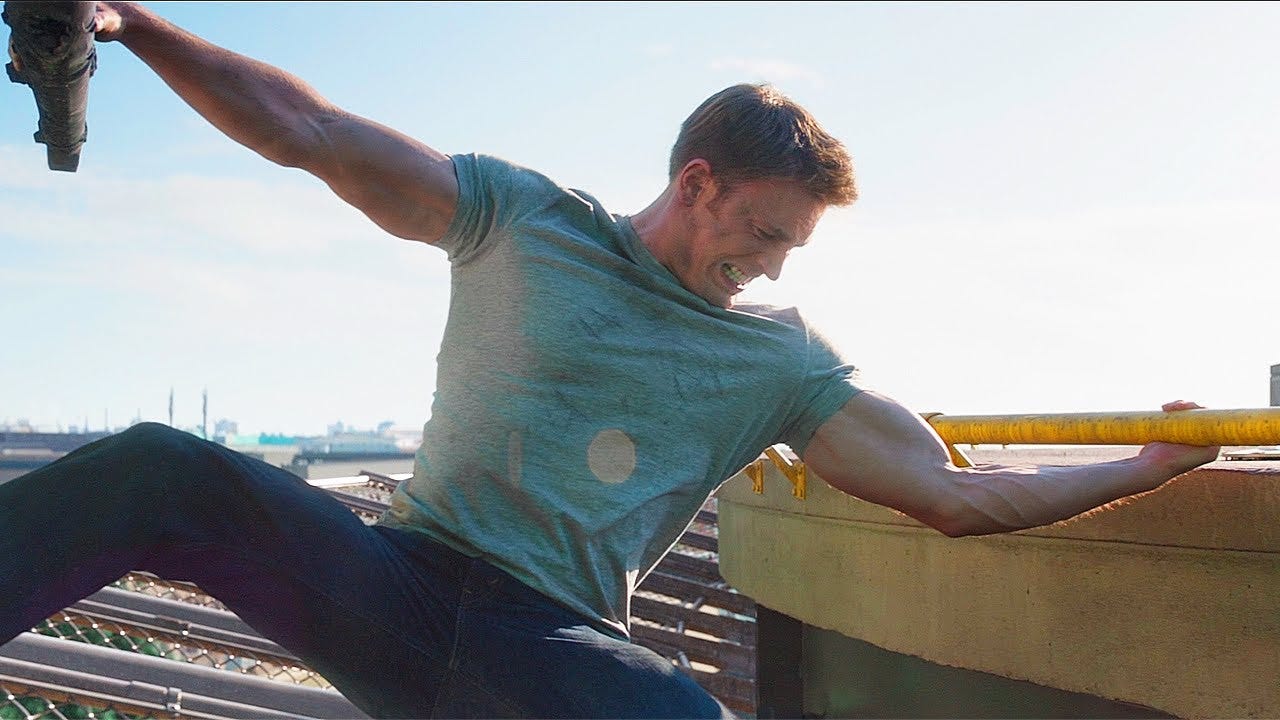
Of all the Marvel movies, despite the fact that it features a rumble between maybe a dozen superheroes, one of which who can grow 60 feet tall, this film is probably the best example of that holy grail story idea in comics of superheroes in the “real world.”
More than any of the recent Batman movies, more than the Boys tv show, and much more than the god awful pile of crap the tv show Heroes was, Civil War accomplishes this by featuring a plausible reaction to the existence of superhumans, especially ones who move across the globe at will with seemingly no concern for sovereign borders or jurisdiction, often leaving a mess of bodies and broken buildings in their wake. Once people begin to find themselves crawling fearfully from the rubble in the aftermath of yet another superhero fight, forced to face the reality that they are nothing more than ants scurrying around the feet of giants—sometimes literally—there’s no other option. That the government would look to aggressively control or contain people like this, all with an eye toward using for their own purposes, is the most realistic outcome of a world where Gods war on Earth.
This is also a good storyline, because it’s very much in line, not just with classic Avengers stories, but with superhero stories in general, as the sins of the past come back to haunt the heroes in the form of old foes, and new villains born of the ashes of their past battles. The remnants of Hydra. The destruction of SHIELD. The legacy of the super-soldier program. The death of Tony Stark’s parents, and his own unresolved guilt. Steve Rogers losing everything he once knew and finding himself alone in a new world. The very of existence of superhumans.
Civil War is a fantastic wrap-up of all these dangling non-Infinity Stone related Phase 1 and 2 plot lines in the MCU, effectively clearing the board for the final run straight into the big narrative event that was Infinity War and Endgame. In a mega-franchise often accused of excessive, despite being filled with colorfully costumed characters and massive action set pieces, Winter Solider and Civil War are somehow very tightly focused films, intent on telling the story of a man trying to find his place in a world he barely understands, struggling with the massive responsibilities he alone must bear, and then finding one thing that matters to him and holding on to it. That they pull it off too, all while acting as the lynchpin to an ongoing and massive narrative, and it’s super awesome while it’s doing it...
That’s impressive. I mean, they’re comicbook-based action movies, I understand that, but still… that’s impressive.
So, yeah… I loved this film too.
And with that, I’ll wrap things up with a few last digressions, if I may…
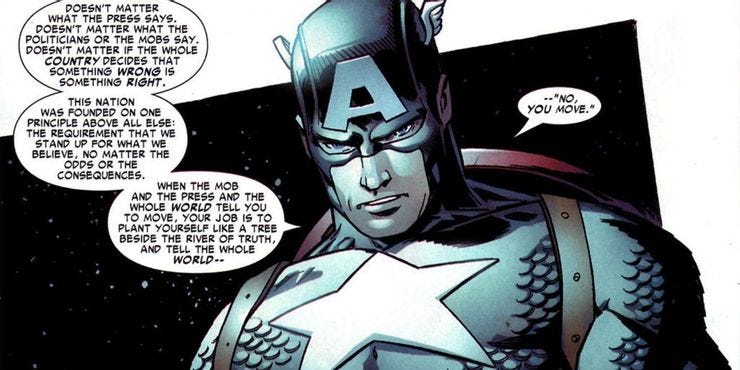
I’d like to give props to the film for using the above quote correctly.
This is a quote that often comes up whenever people talk about Captain America, holding it up as a good example of his resolve, his determination, the strength of his principles, and his belief in doing what’s right. And sure, I can see that, but it’s also a quote that makes me a little wary. To me, upon reading it, it seems like the type of thing that you also often see being trumpeted by people like the bigot asshole MAGAs or their vapid selfish shithead anti-vaxxer/maskers friends, using this kind of idea as a smokescreen of righteousness for their cruelty and entitlement based causes.
So, while this kind of misuse can be used in comics as a good way of illsutrating the kind of twisted funhouse mirror versions of the ugly and all too real mainstream ideas that the evil 1950s Cap( and the more modern version of him, Hydra Cap) represents, I mostly dismiss this quote as bullshit, as in the real world, it is too often just a willing cudgel waiting for some asshole to pick up, but that having been said, in the movie Captain America: Civil War it’s used correctly, and I appreciate that.
I aslo liked how the death tolls and the resulting political fallout from the events of the previous films highlighted a specific issue that’s long marked the main difference between the films of the MCU and the films of the DC Snyderverse.
In the films of the MCU, people die during these superhuman battles, lots of people, because that’s what happens when buildings get blown up, or knocked over, or when cars are getting thrown around, but still… during all the chaos, the heroes are shown trying to protect as many people as they can. They are consistently shown saving lives. Meanwhile, in the Snyderverse, Superman is not only letting an alien spaceship crash into the middle of downtown Metropolis, he’s even throwing it down. He’s also shown jumping over a thrown semi, and letting it blow up a gas station, instead of just like… not letting that happen. This is the fundamental failure of the Snyderverse DC films, and it also shows how the Marvel films understand the actual role of the characters… It’s to help people, to save lives. It’s not supposed to be about getting in a ruckus, it’s supposed to be about trying to stop one… most of the time, unless you’re at an empty airport, because then?
Fists? Meet Faces.
Also, people complain that Zemo’s plan was too complex here, but it’s not, it’s very simple… Zemo’s whole plan is simply to get Cap and Tony in the same place, and to then tell Tony the truth about Bucky, that as the Winter Soldier, Bucky killed his parents, and that Cap already knew this after the events of Winter Soldier, and after that… just let them be who they are. The plan is to get them to tear themselves apart. All he needed to do to make this happen, was to force the issue of Bucky, and use it to force a wedge between Tony and Cap, and then use Bucky’s past to point them all toward the jaws of the trap. The audience expects the same ending as our heroes, we all think the climax is going to be Cap and Tony versus a room full of insane super soldiers, so we all walk together straight into Zemo’s trap.
And it works.
Zemo wins. He breaks the Avengers. No matter how everything else turned out for him, Zemo managed to accomplish his goal, and he’s the only villain that’s truly won too. Well, him and Thanos, but even then, without Zemo’s victory, Thanos might not have ever had his.
Nerds get mad and say, spitting and red-faced: “So, Zemo planned for all this to happen exactly like it did? He planned for the airport fight, for only cap to get away, and for Tony to need a push in the right direction to follow them?” Which is weirdly aggressive for being contrarian about a superhero movie, but the answer is… yes and no, you dumbass. He’s a supervillain, for one. Two, this is a comicbook movie, so calm down. But yeah, this was the whole point, make Tony chase Bucky, so that Cap has to save Bucky, then use Bucky to point toward more Winter Soldiers still on ice, and let them discover that Zemo was behind it, and let them think he’s planning on using the other Winter Soldiers for more assassinations, so that at the very least, all three of them have to chase that problem, and then when they’re all there… simply hit play on the VCR. Yes, he had contingencies. Yes, he adjusted on the fly. Yes, it’s all crazy. But that’s what motivated and manipulative mastermind supervillains do.
Besides, it was a long time coming. Tony has always had issues with Cap, mostly due to his unresolved daddy issues, and also because Cap and Howard Stark were friends in WW2, and Tony has always been jealous of that. Plus, in the comics, Cap and Tony have a long history of disagreements that come to blows, it’s just who they are, they’re a pair of big swinging dicks who usually just punch their way out of their problems.
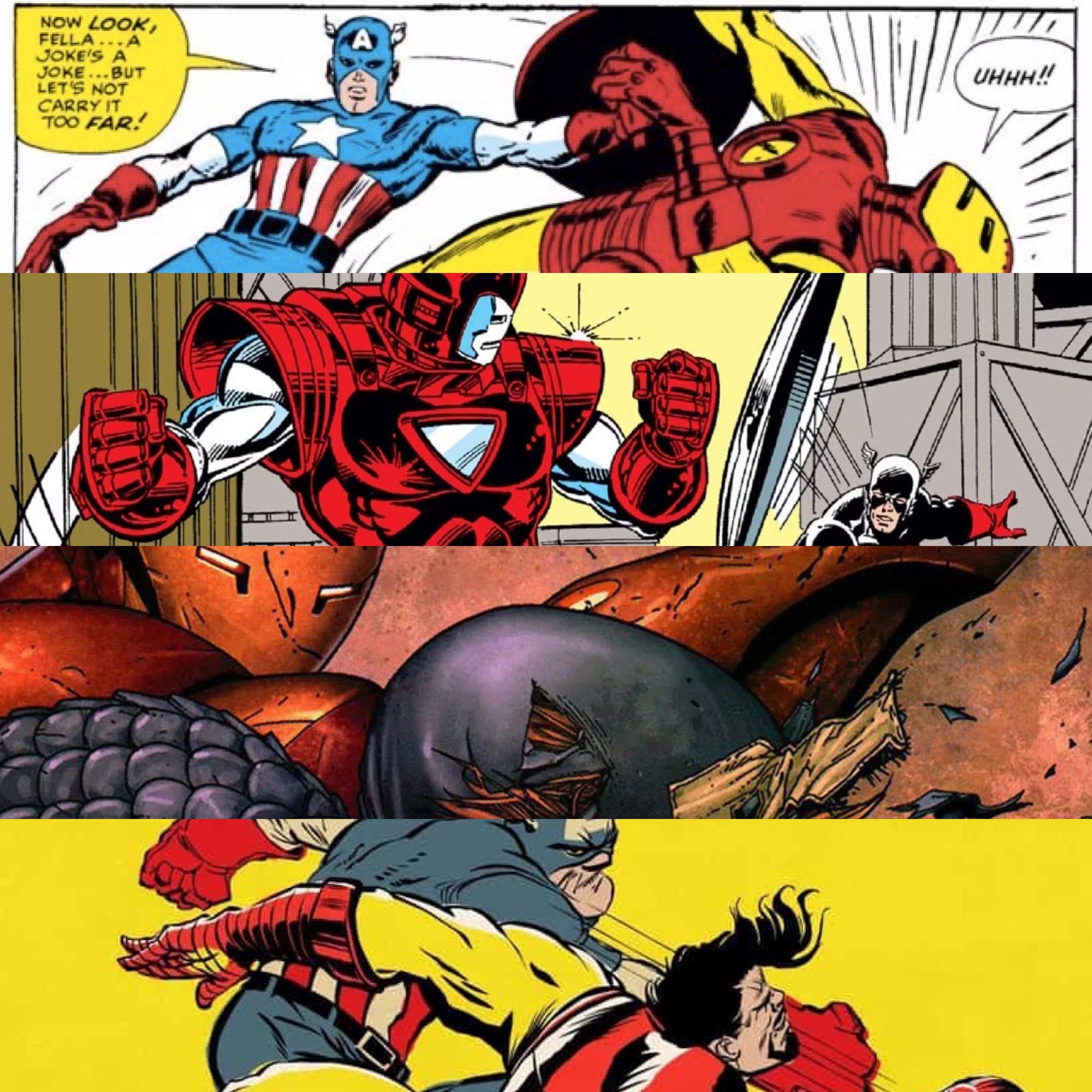
So, Zemo’s plan? Easy-peesy lemon squeezey.
People also complain about Spider-man referring to Empire Strikes Back as “that really old movie,” but that’s just old people not liking the idea that they’re old, even though they are… they’re really, really old.
Think about this way… The MCU Spider-Man was 16 in 2016. Empire Strikes Back was released in 1980, which, at the time, was 36 years prior. Now think about that in terms like, say… if you were 16 in 1992. If that was the case, then a movie that would’ve been similarly as old at the time as Empire Strikes Back was to Spider-man when Civil War was set, then that film would’ve been released in 1956.
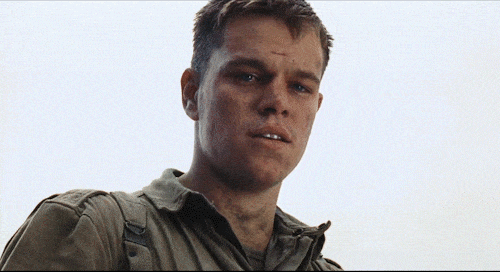
Enjoy pondering that shit for awhile.
And finally, with full acknowledgement that I have gone on once again at great length… here’s something that I just noticed upon this most recent rewatch, and it mades me wonder. It’s probably nothing but… Does Wanda already have a copy of the Darkhold on her bookshelf in her room at Avengers’ Compound?
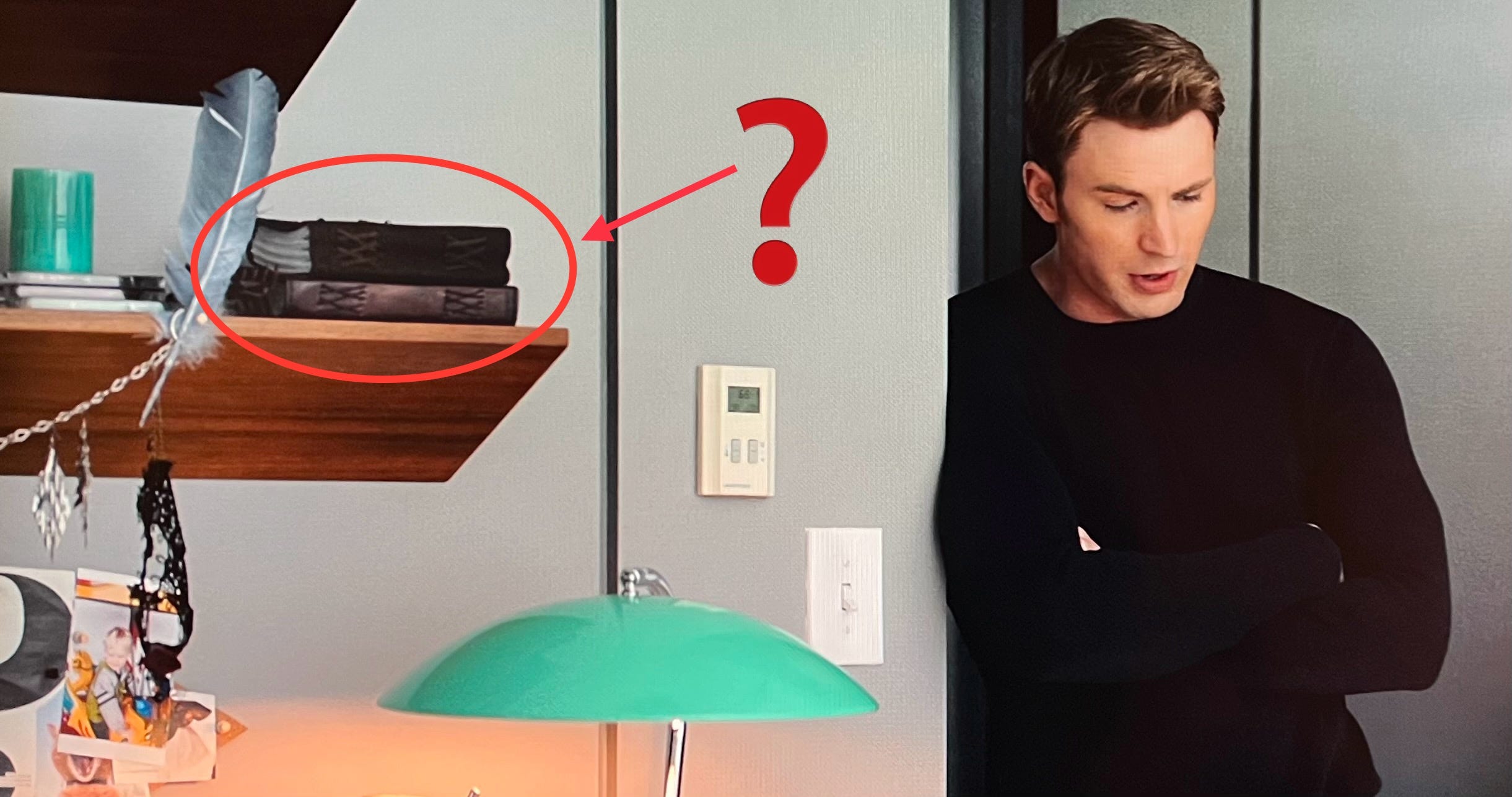
Hmmm… probably not, but still, kind of cool to assume it is, knowing how it all worked out, right?
And with that, we’re done here. Thanks for reading, True Believers! Tune in next time for another spine-tingling installment of Rewatches and Rememberances!
Excelsior!
